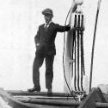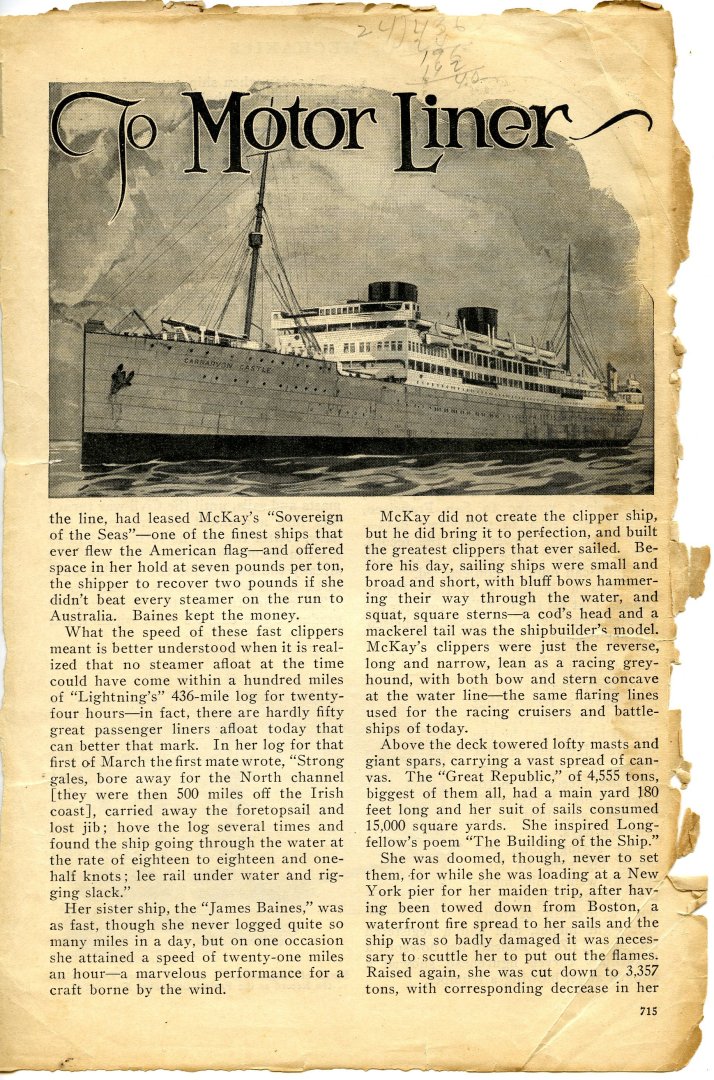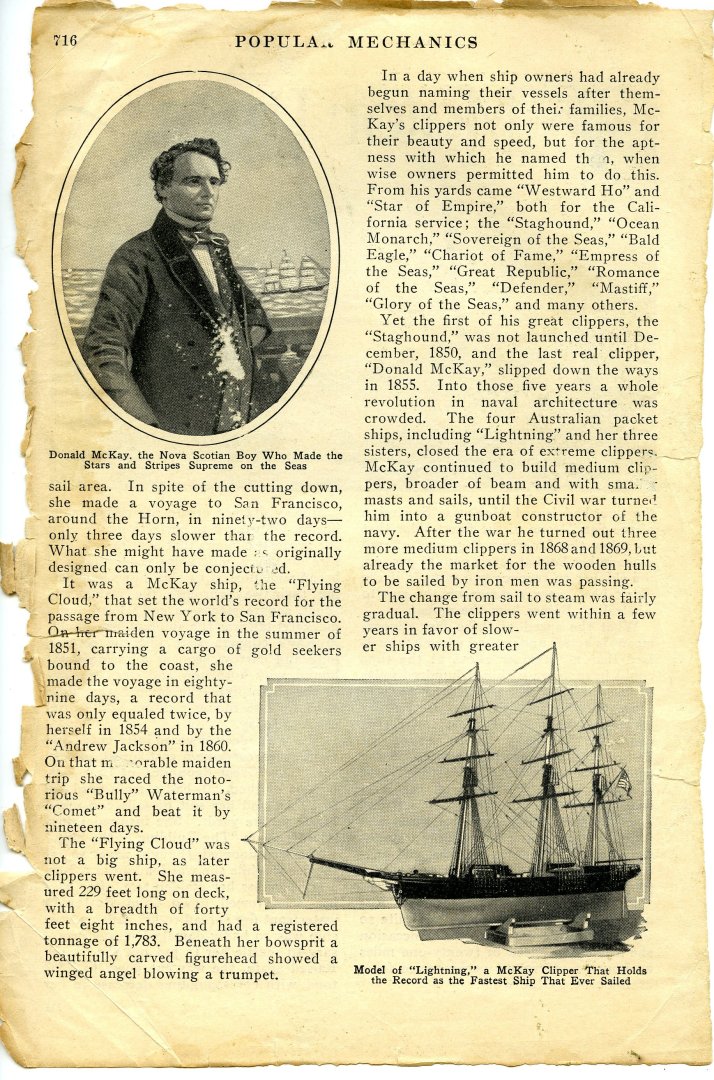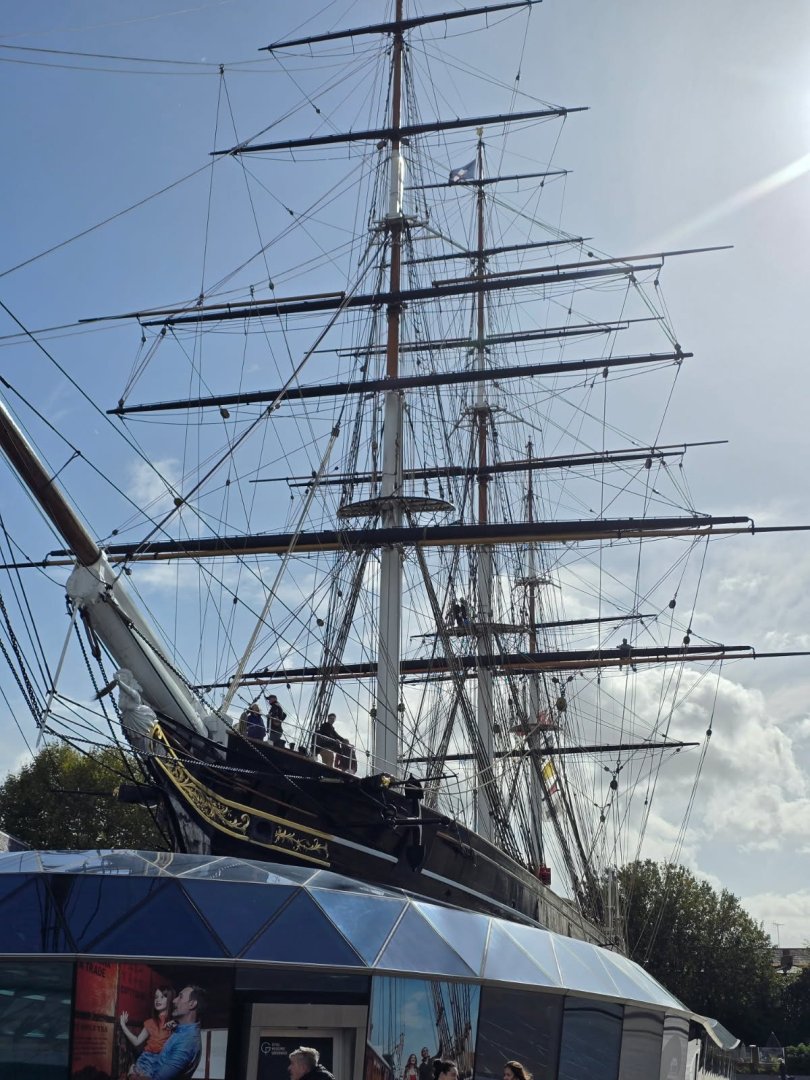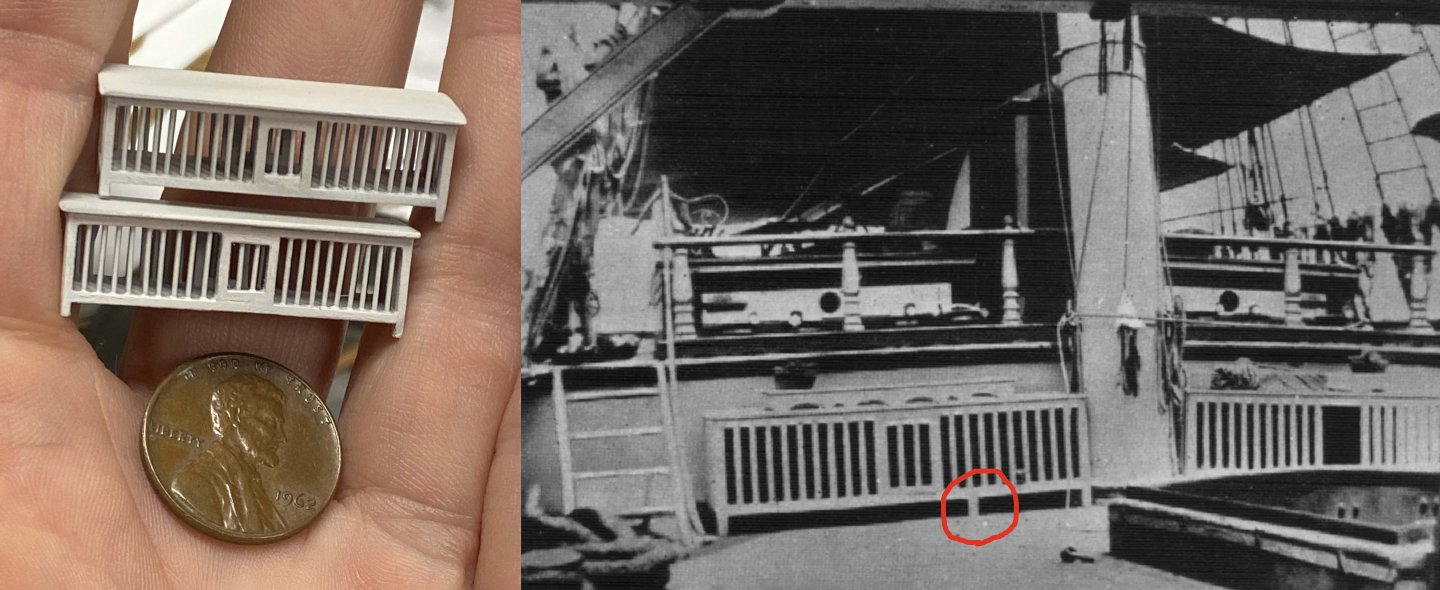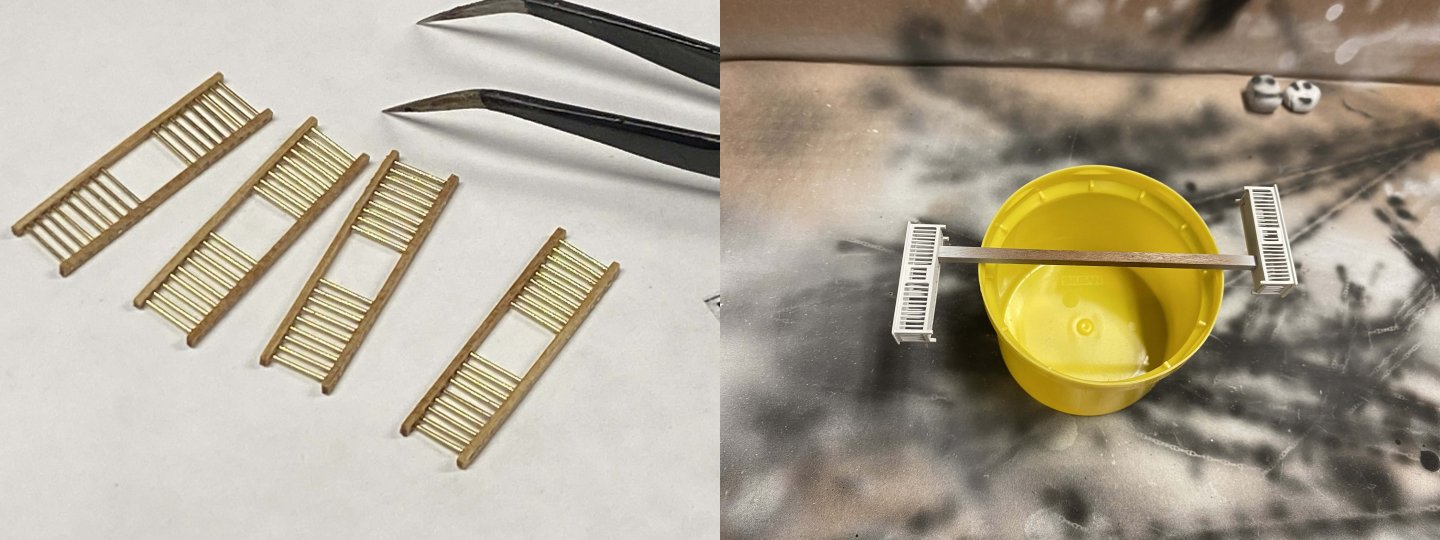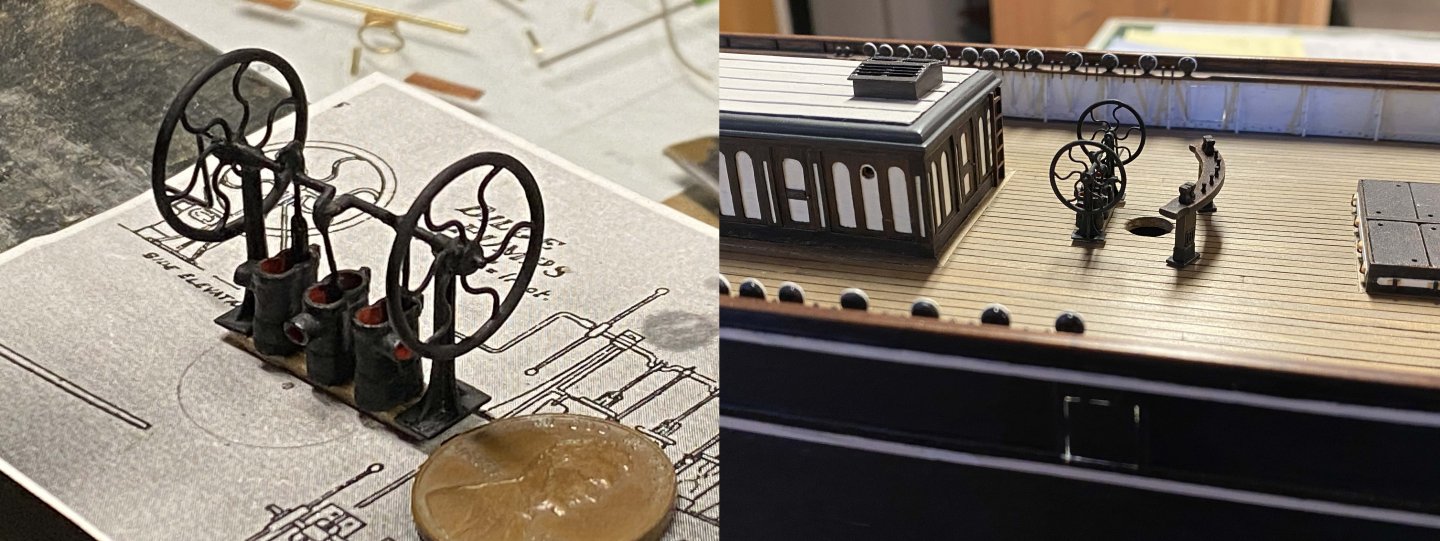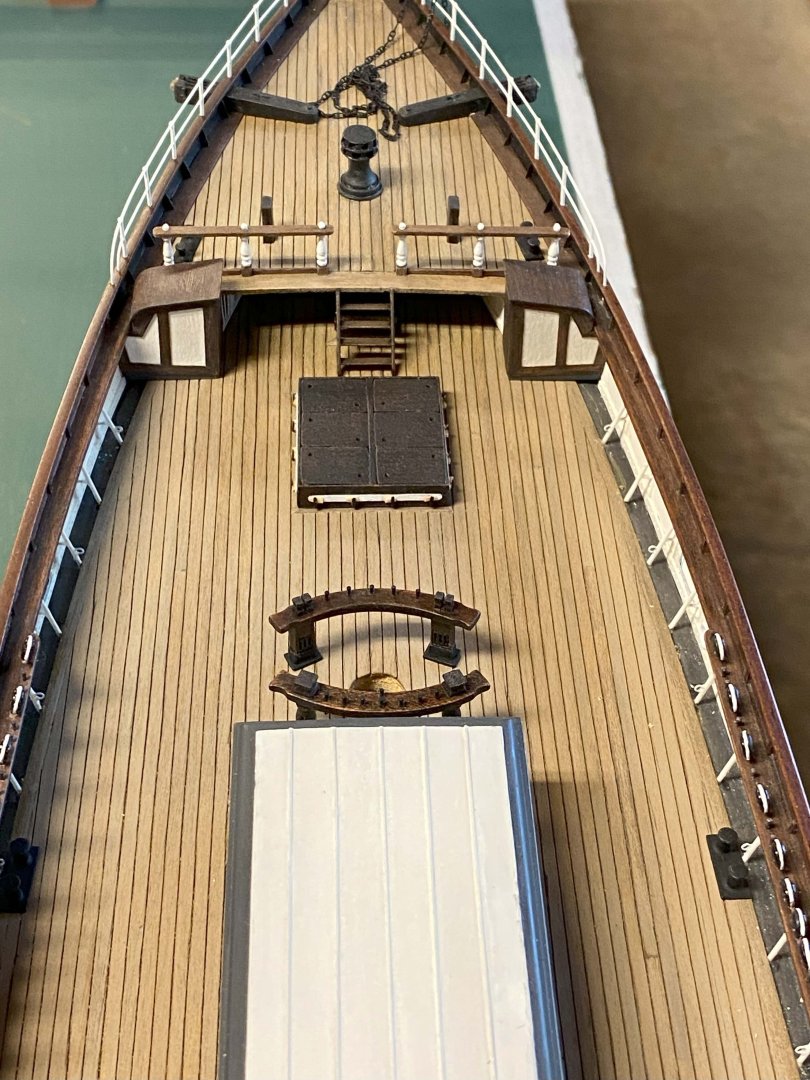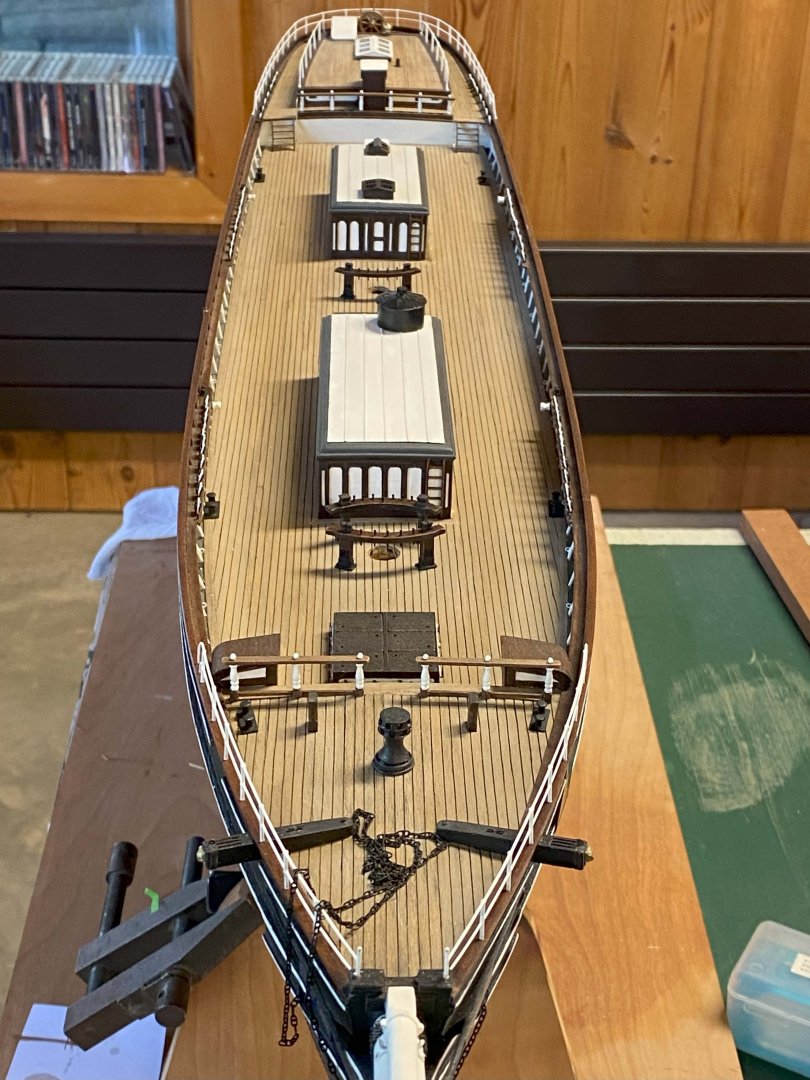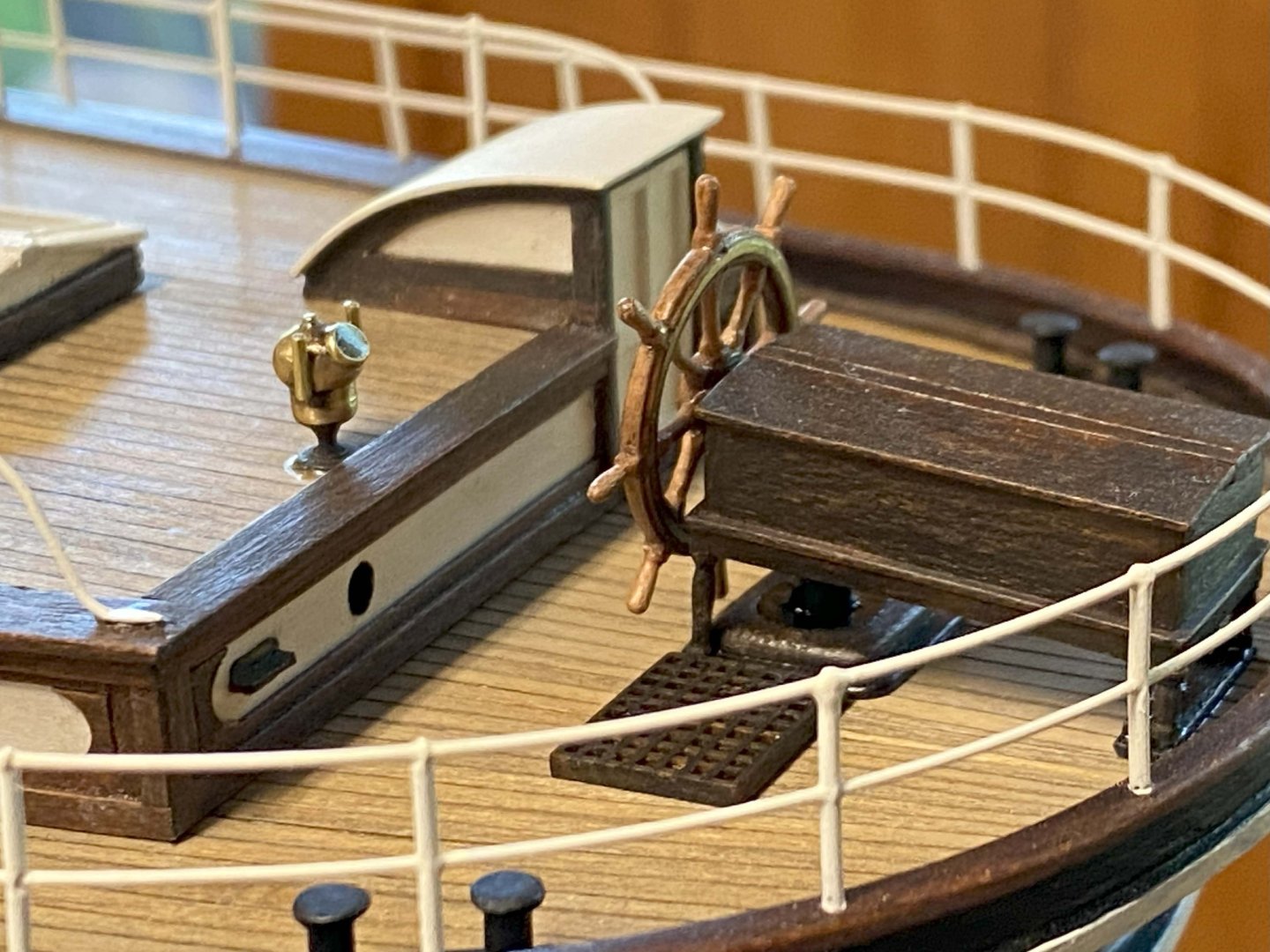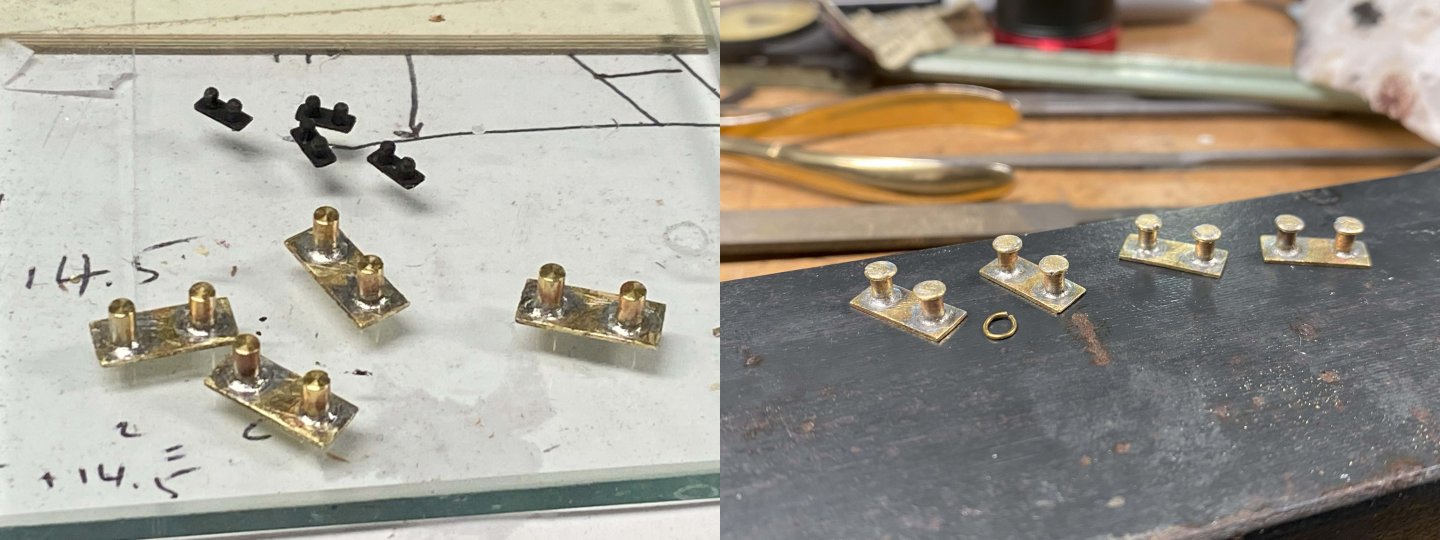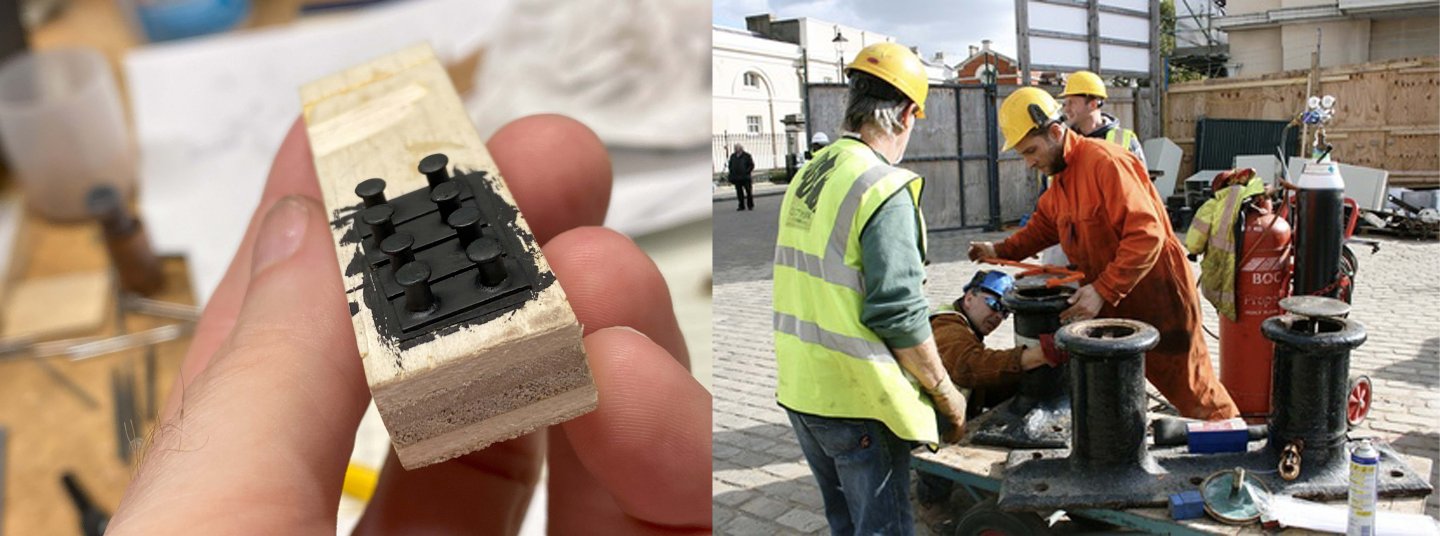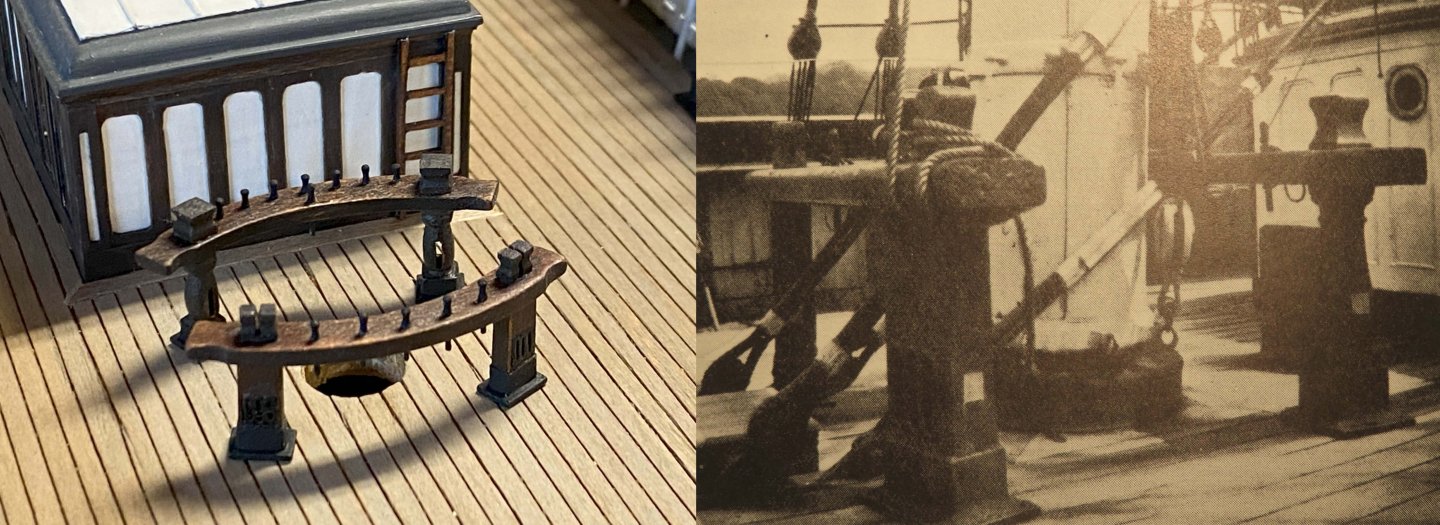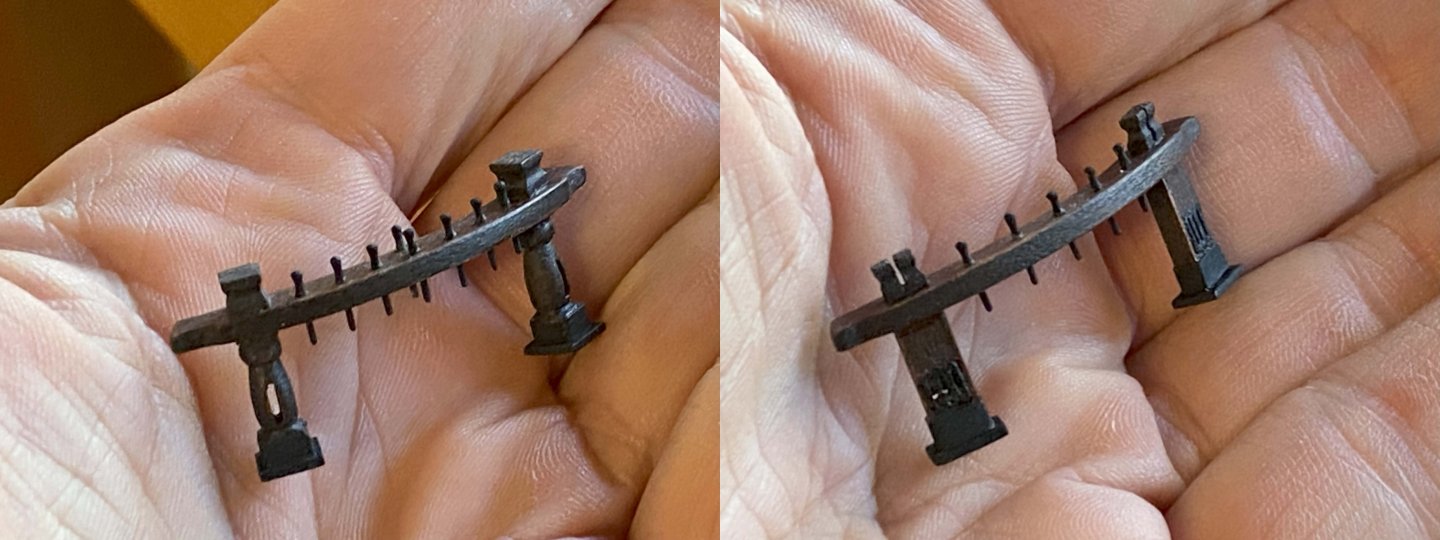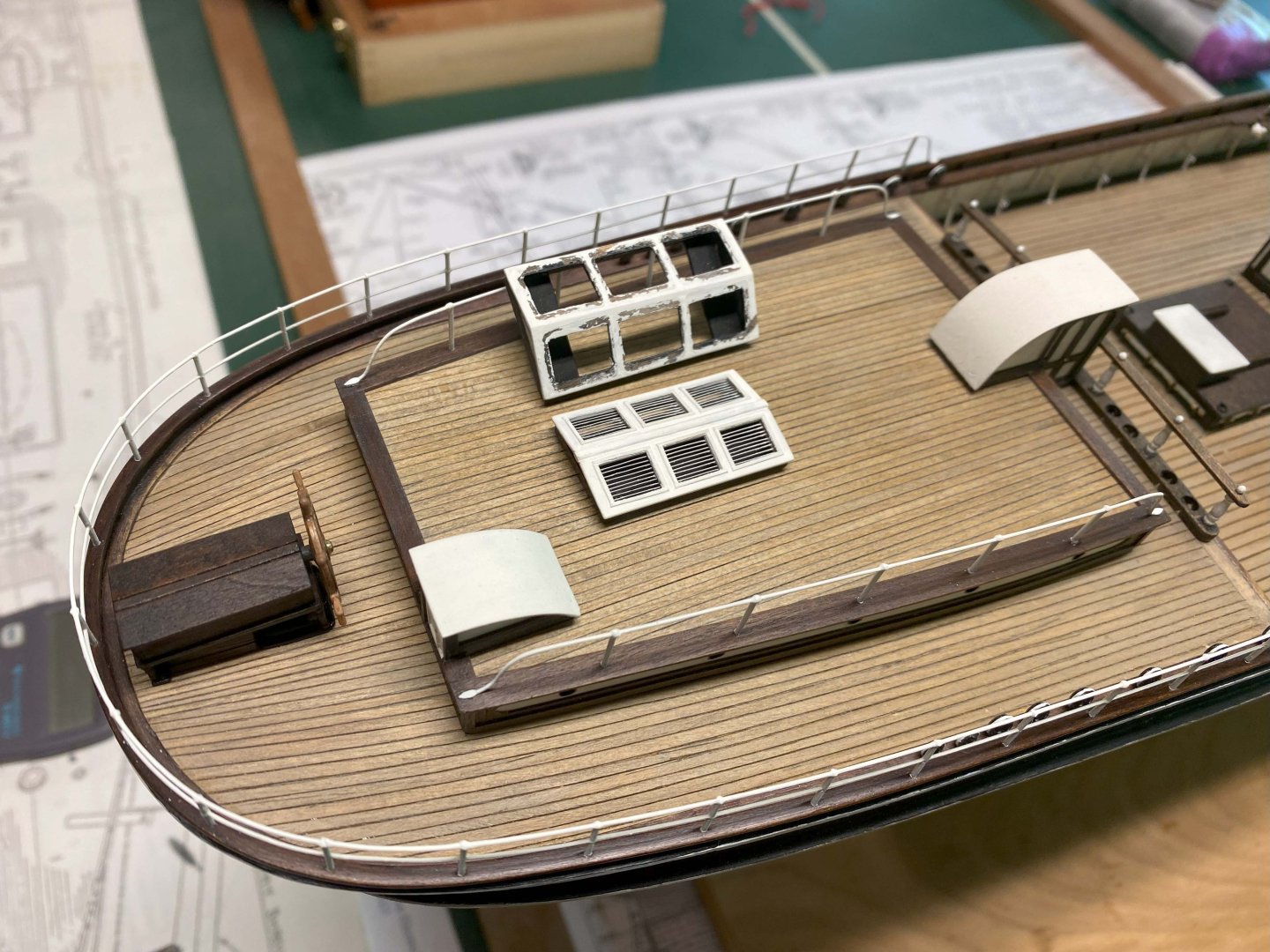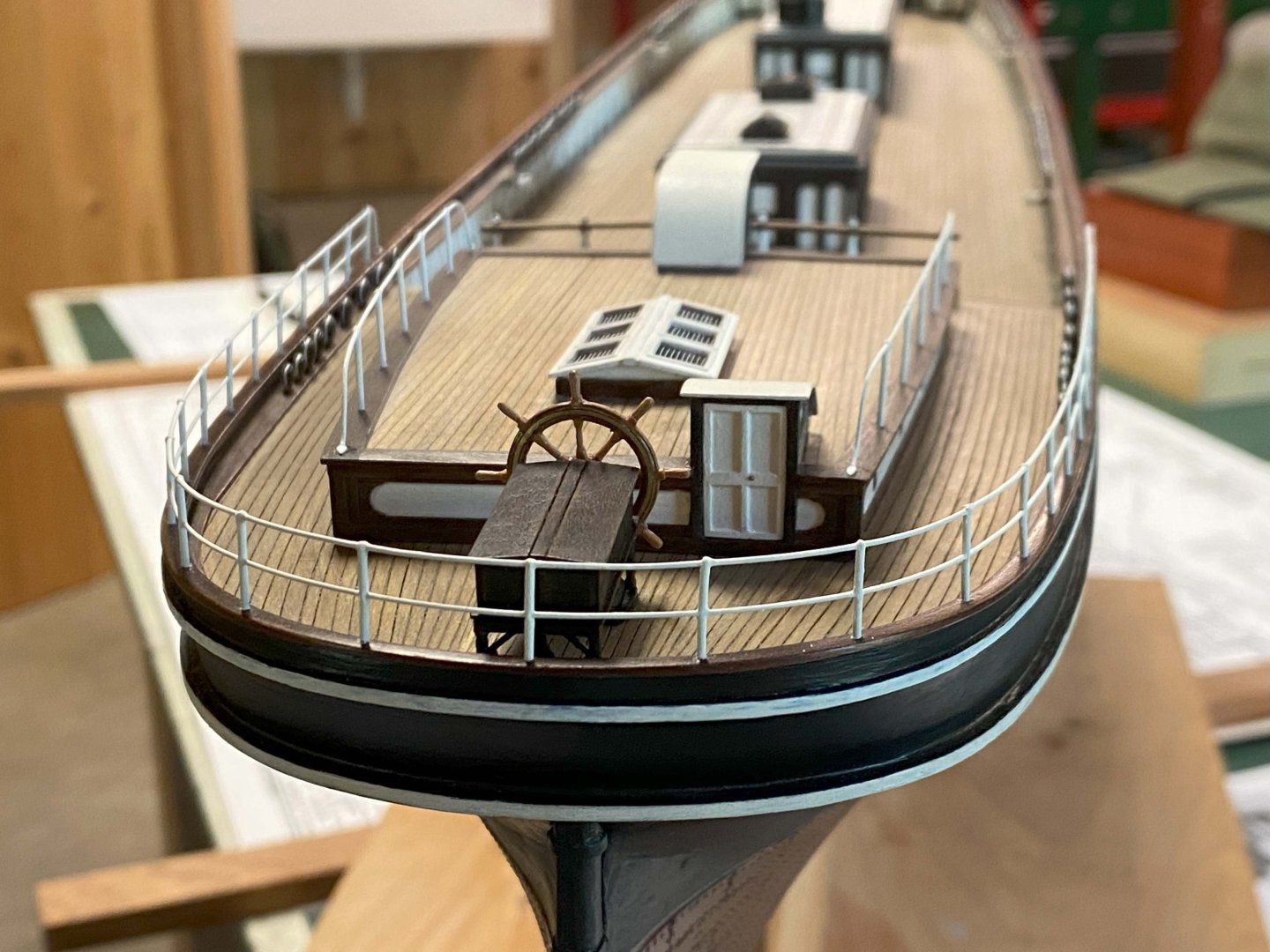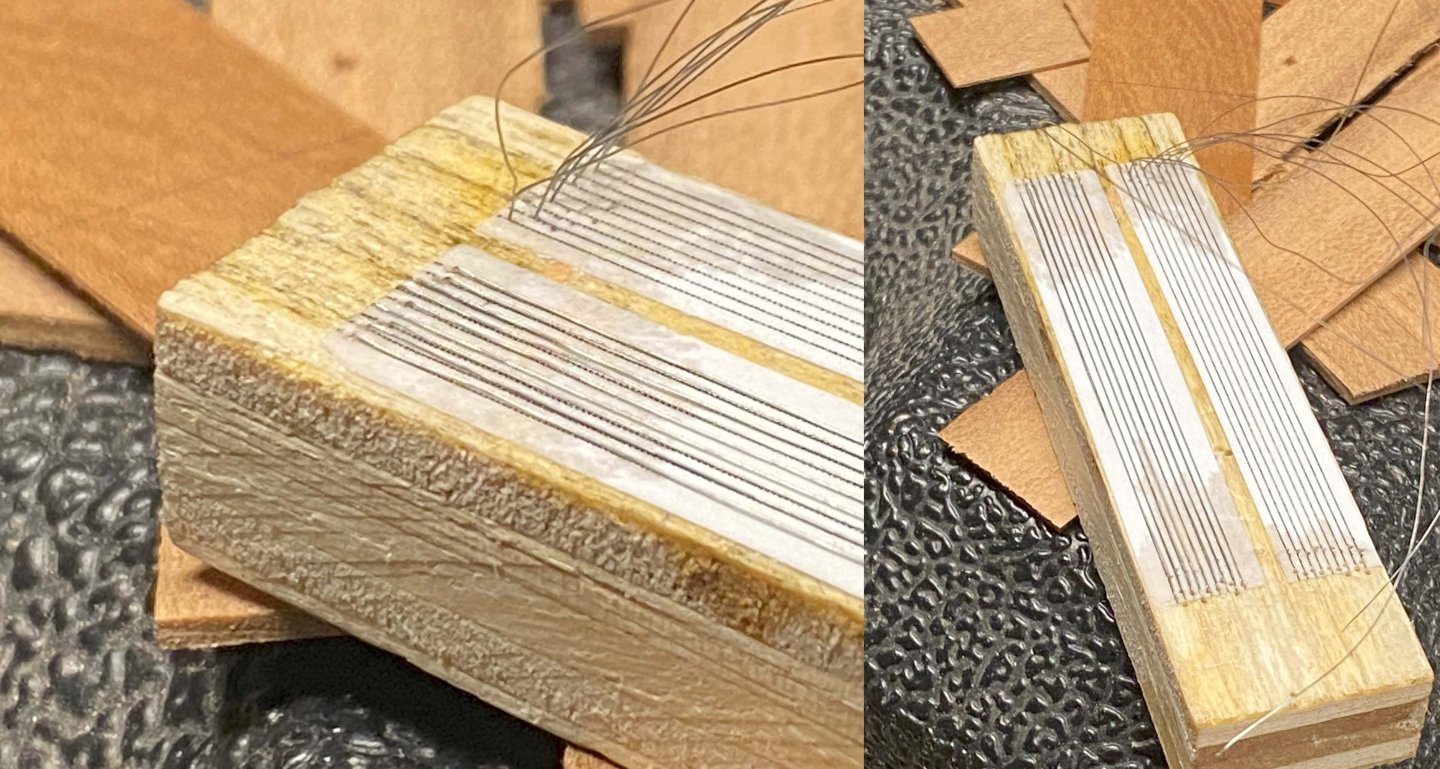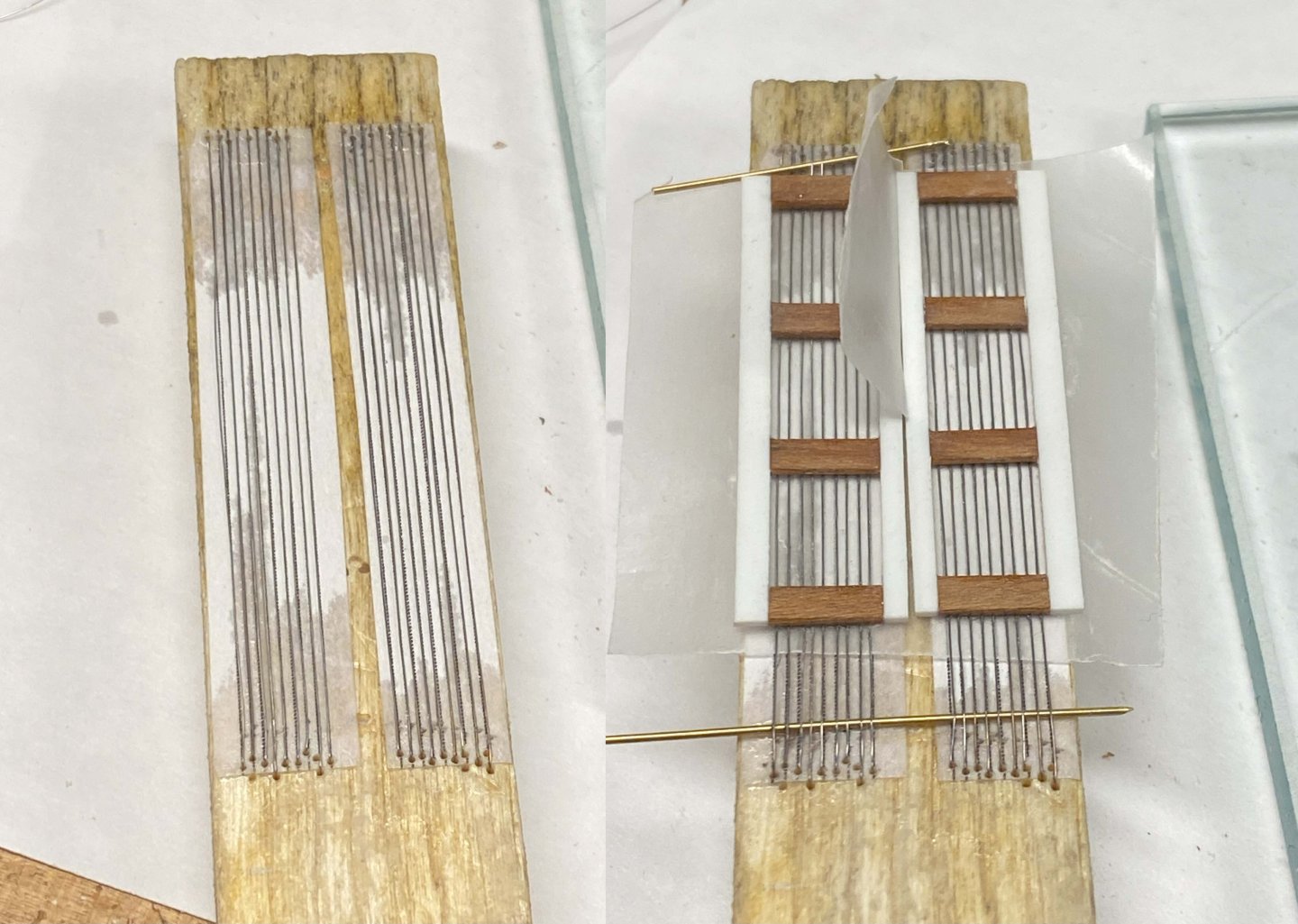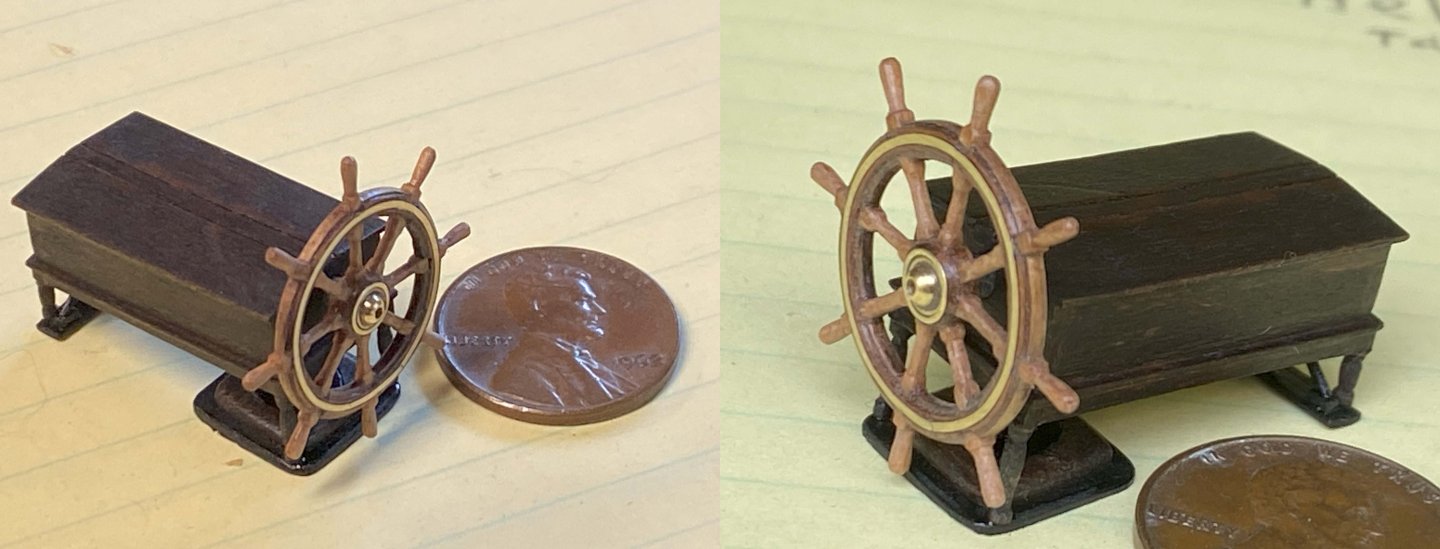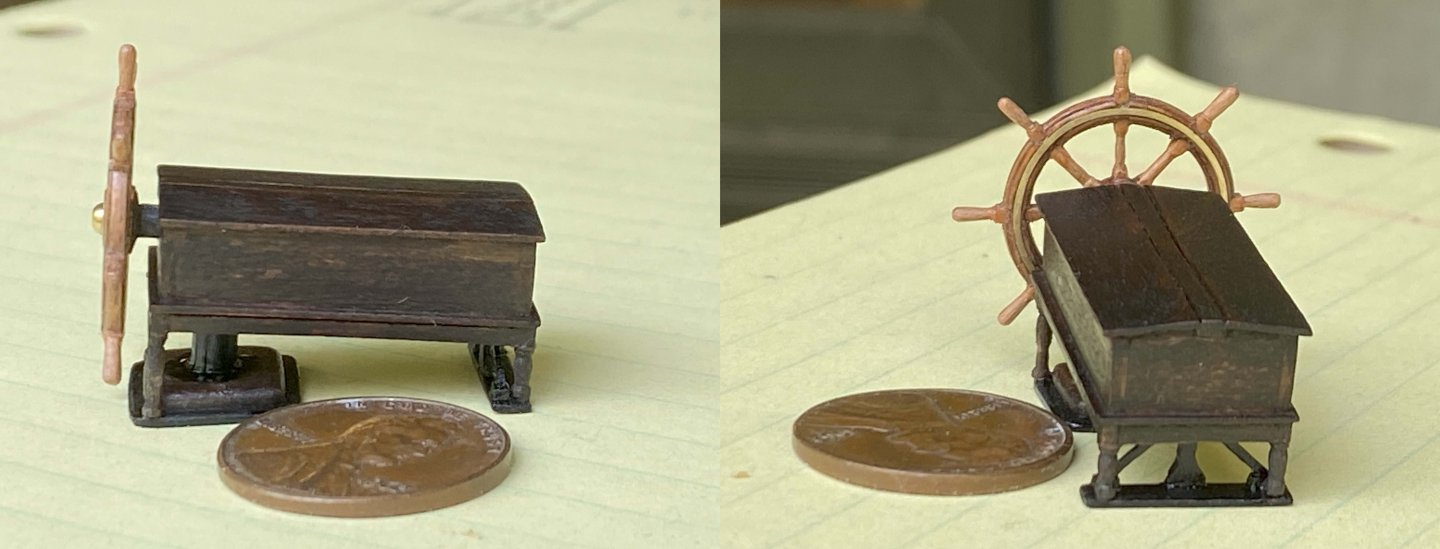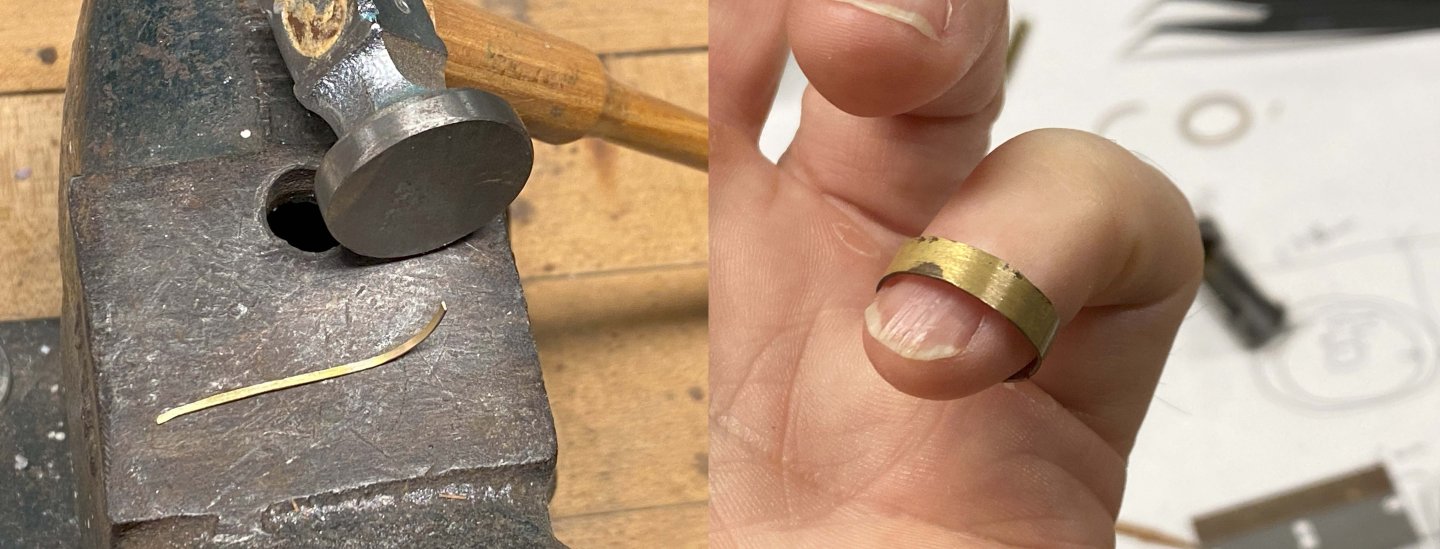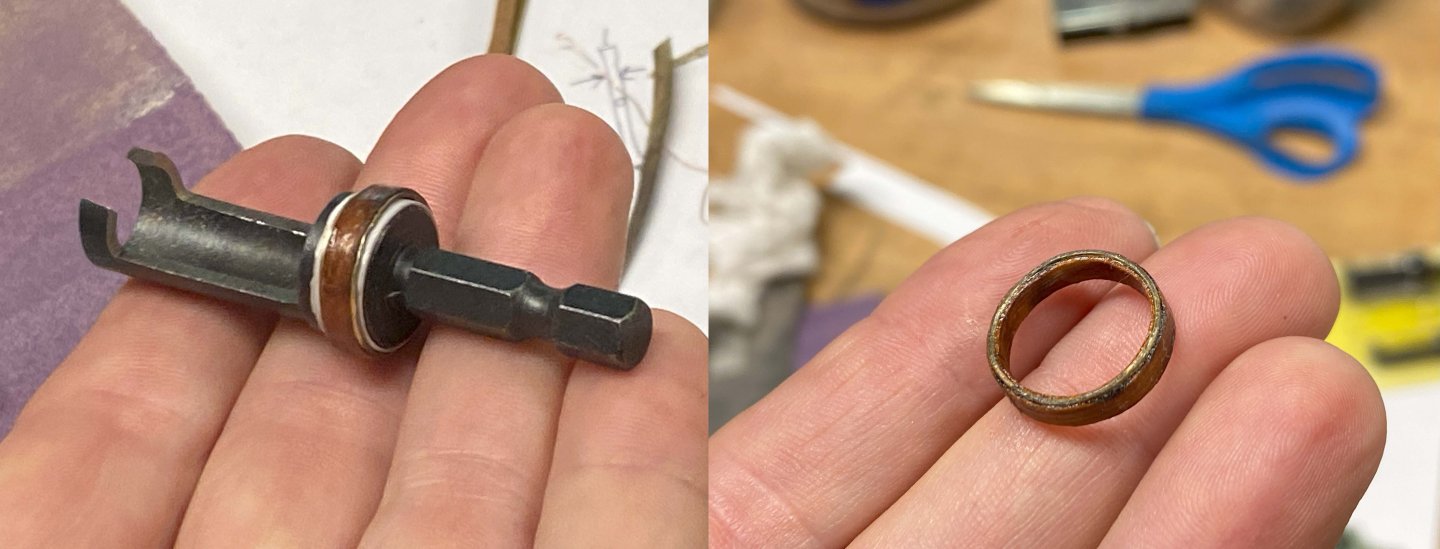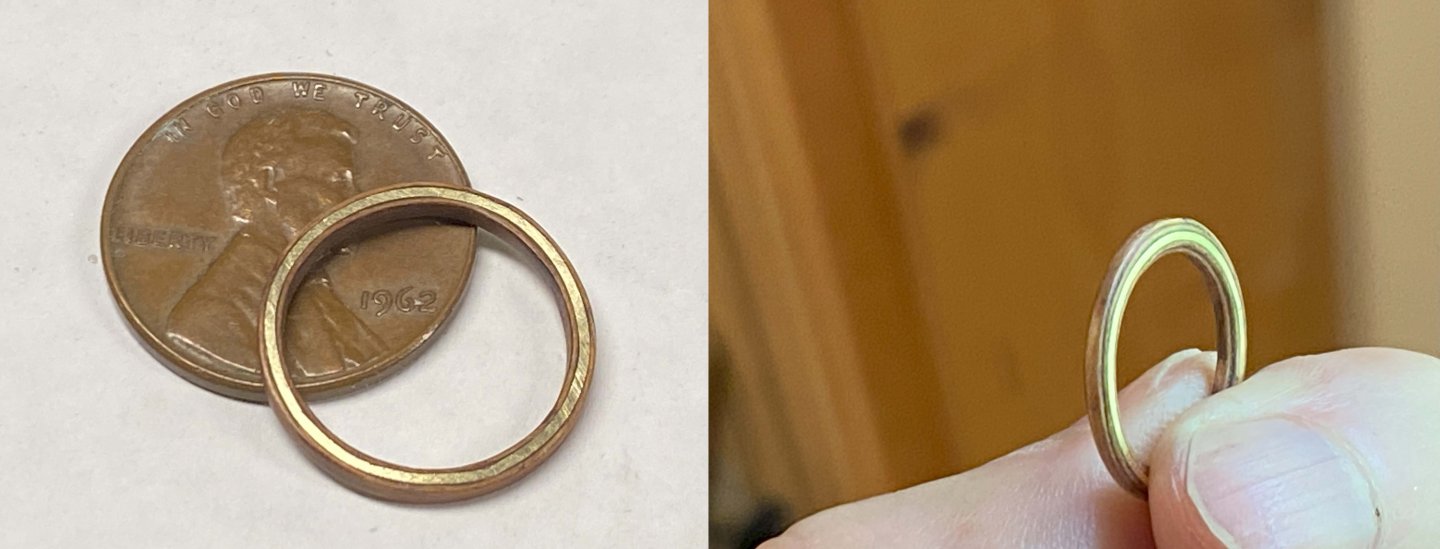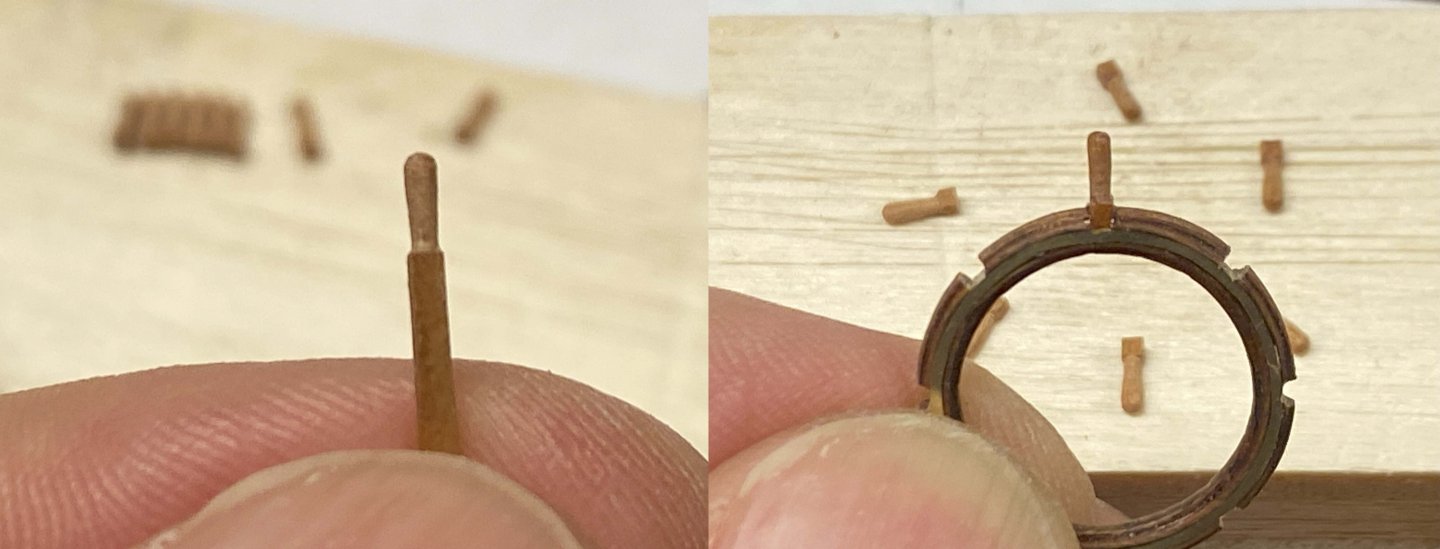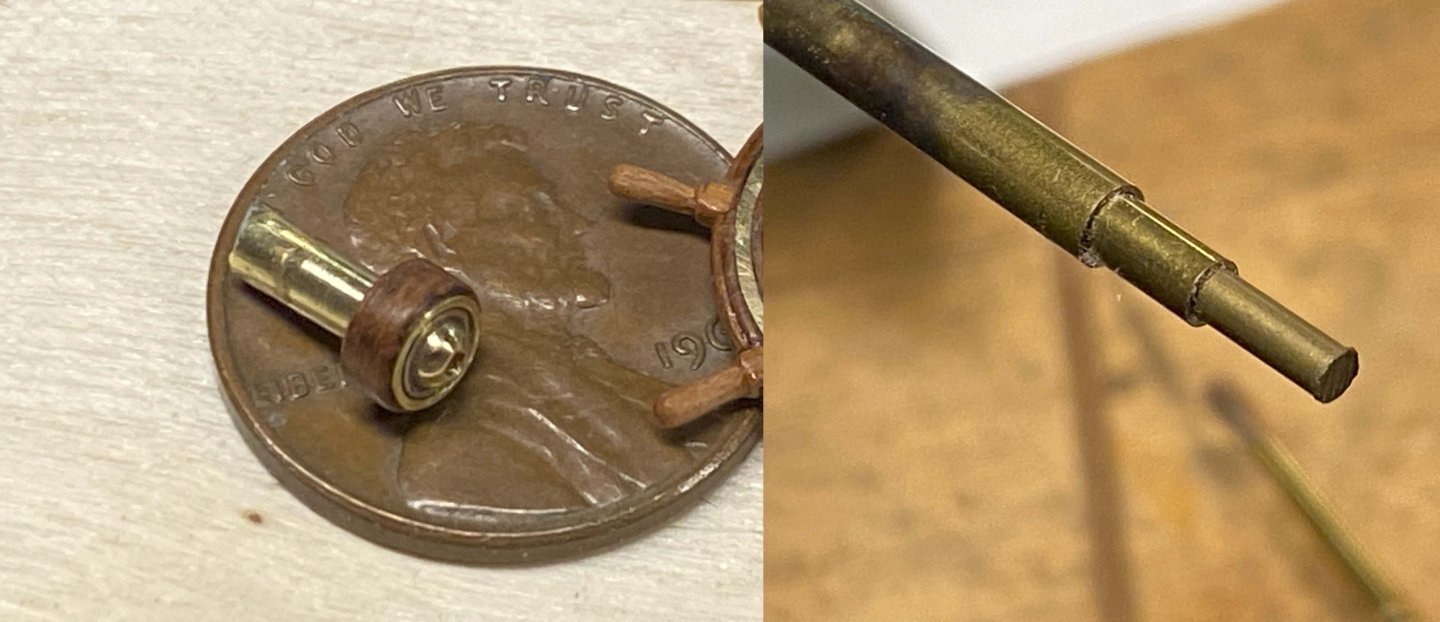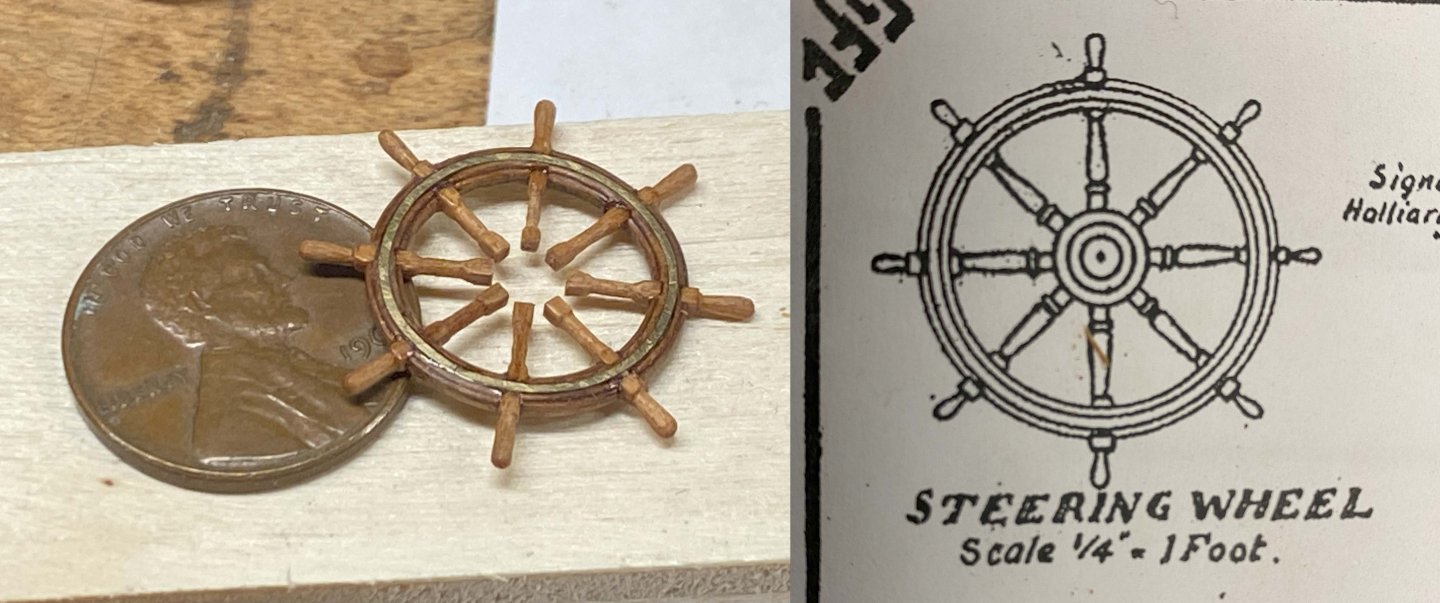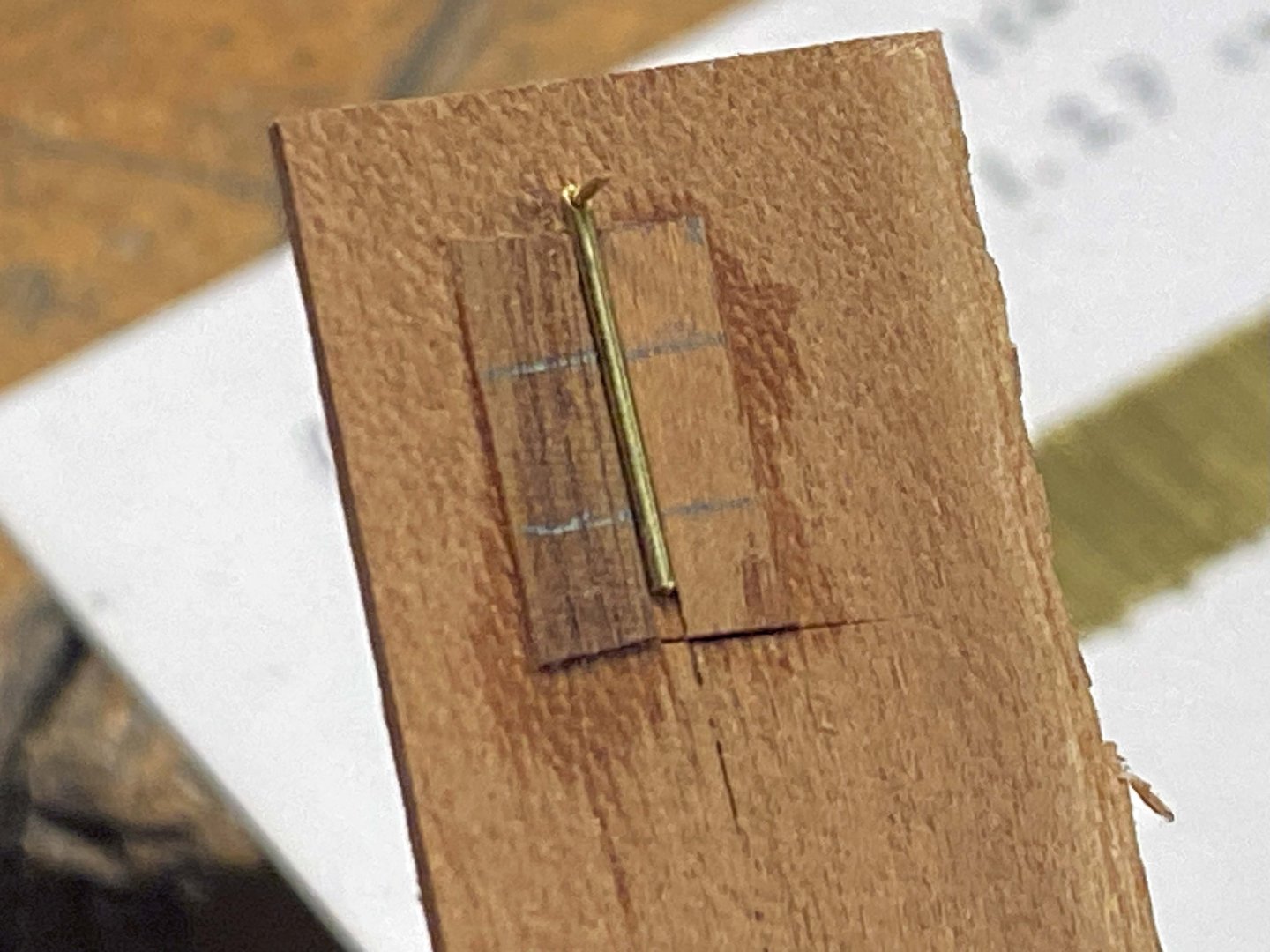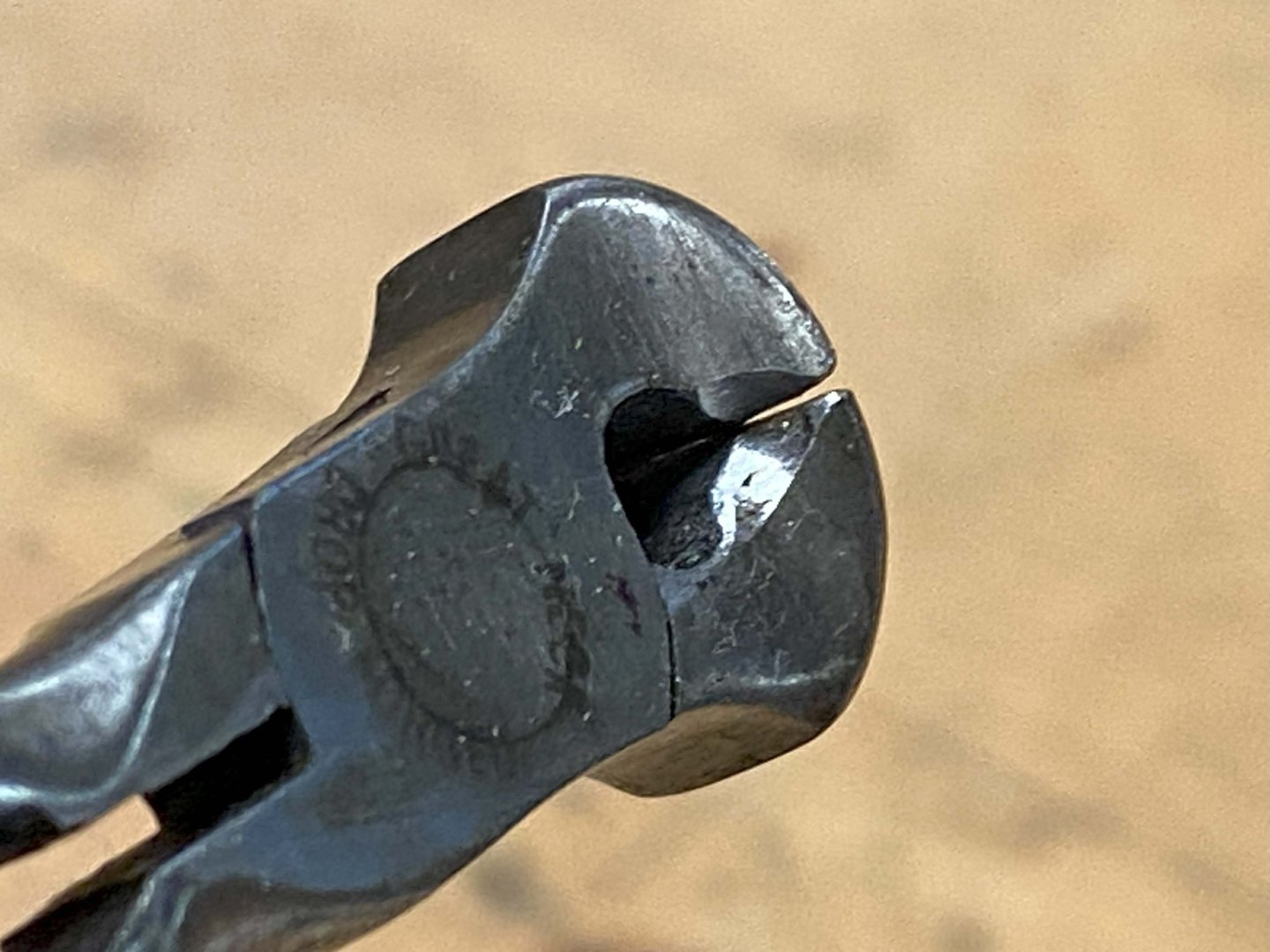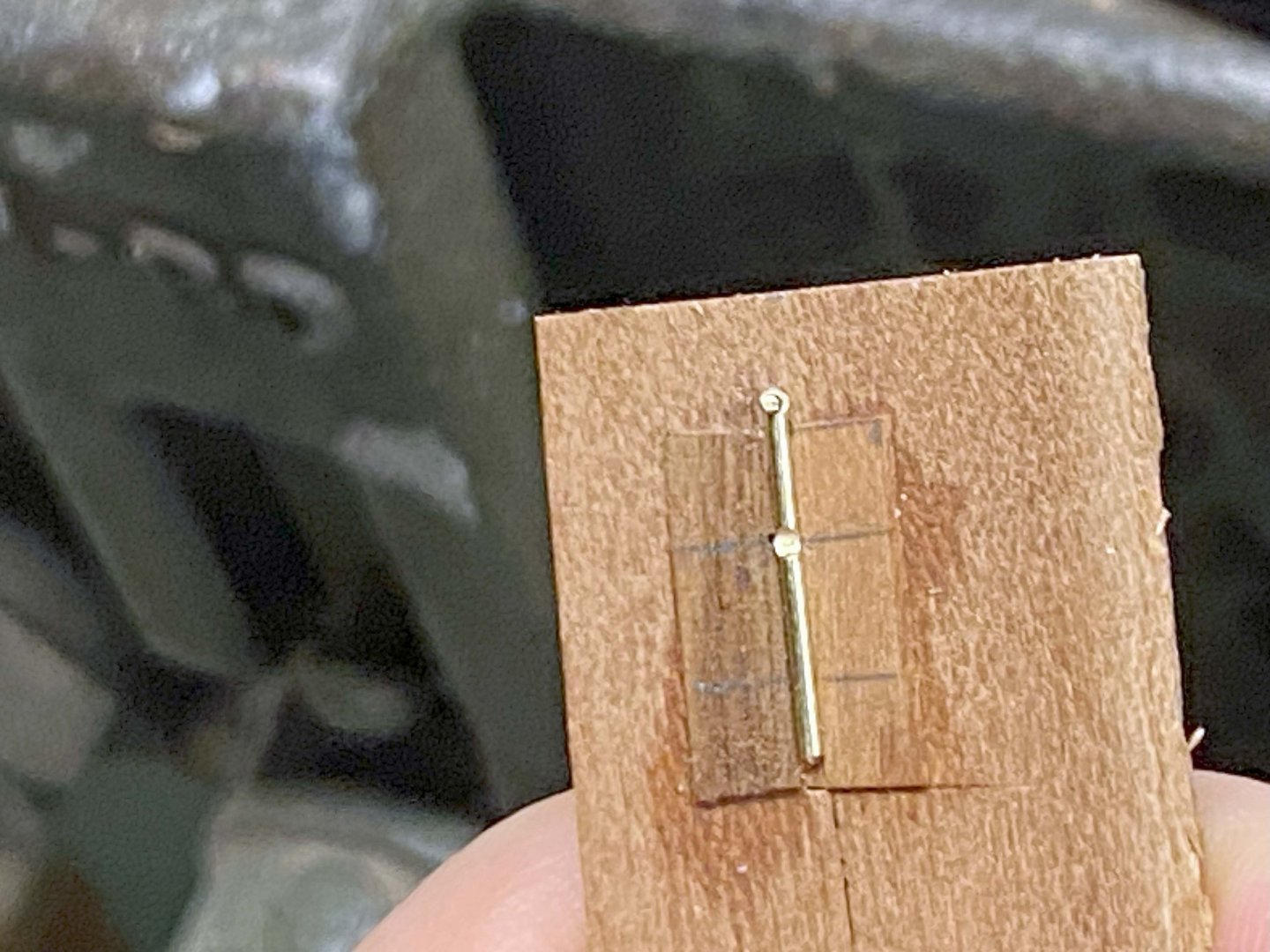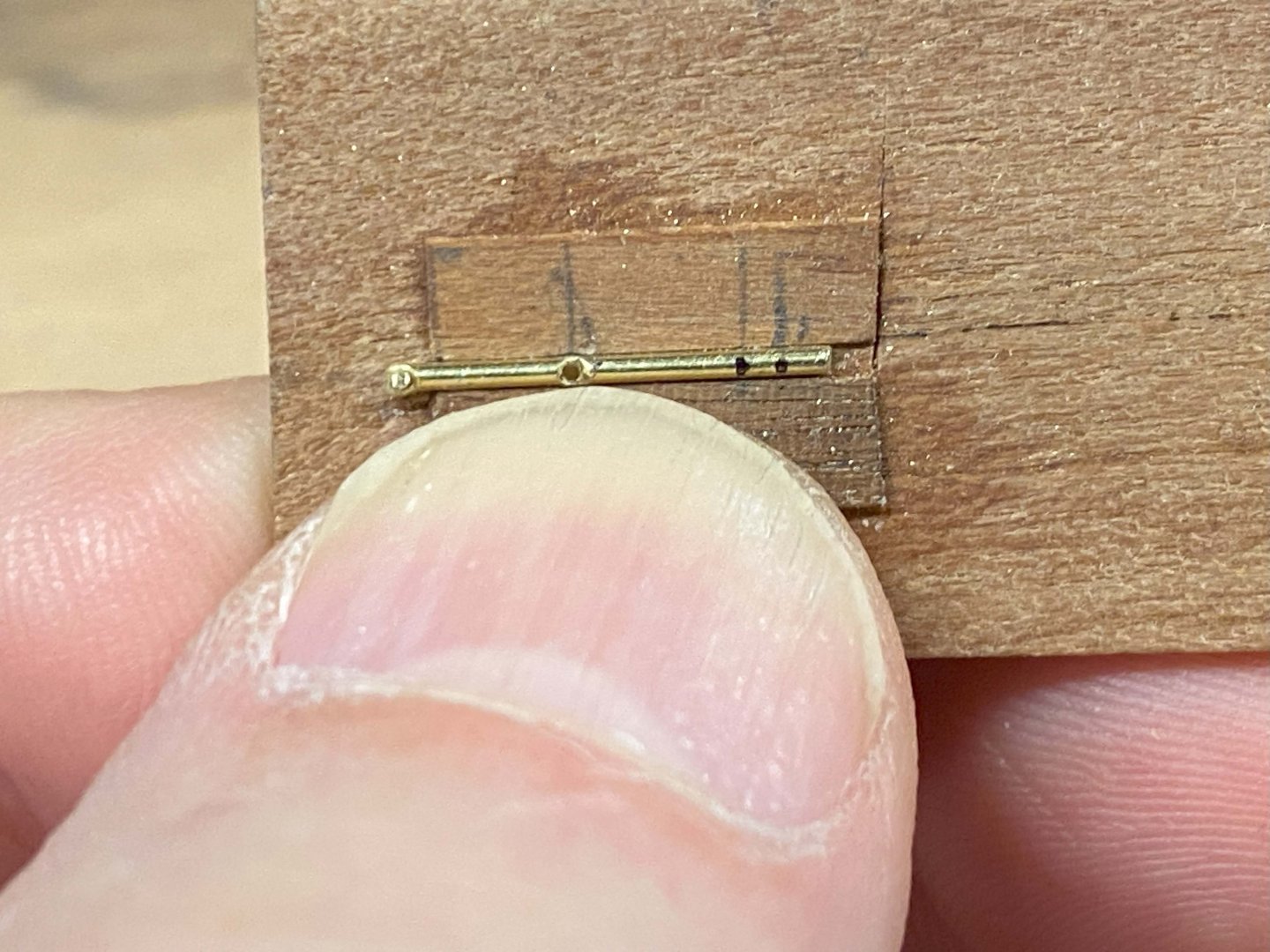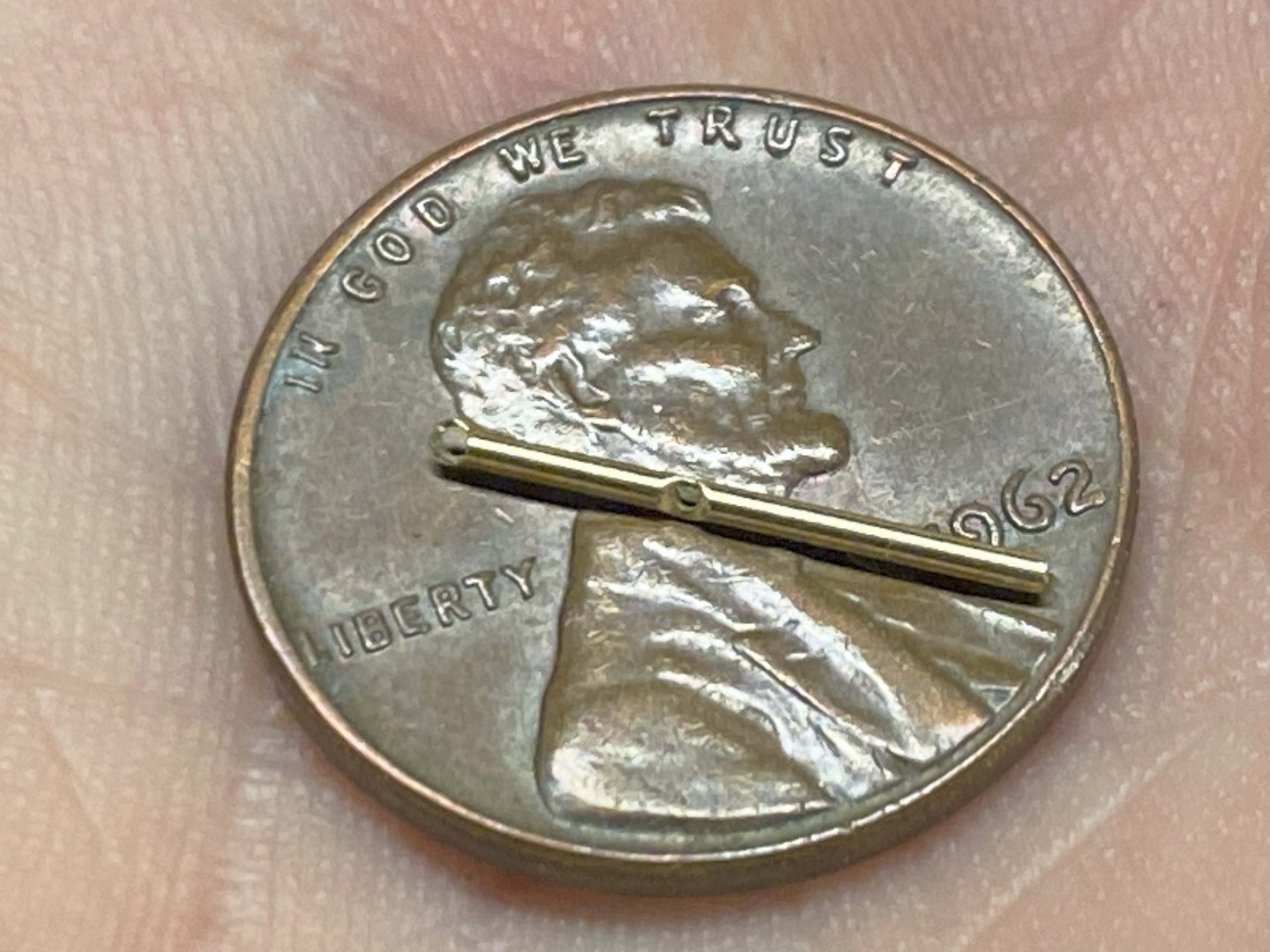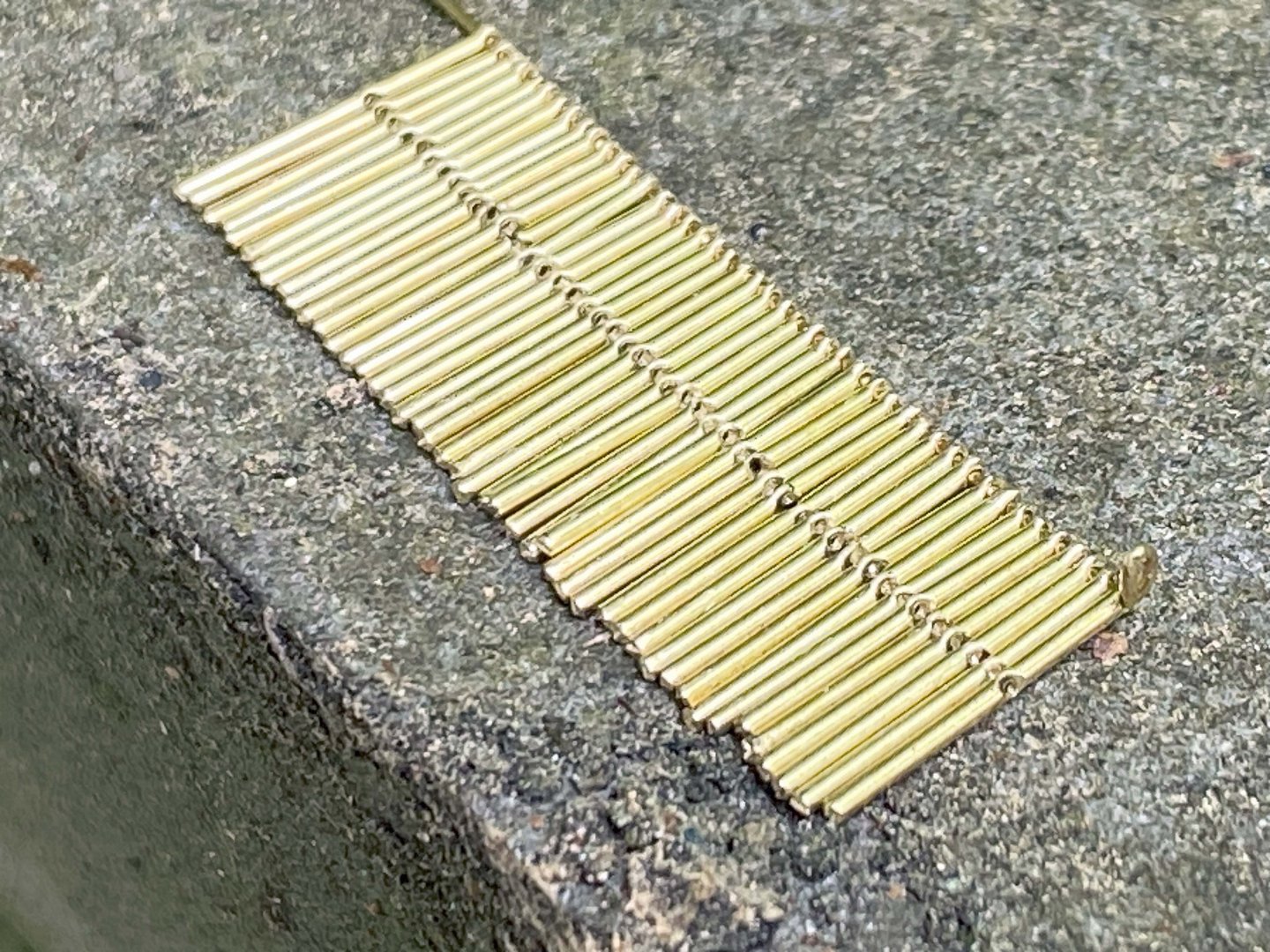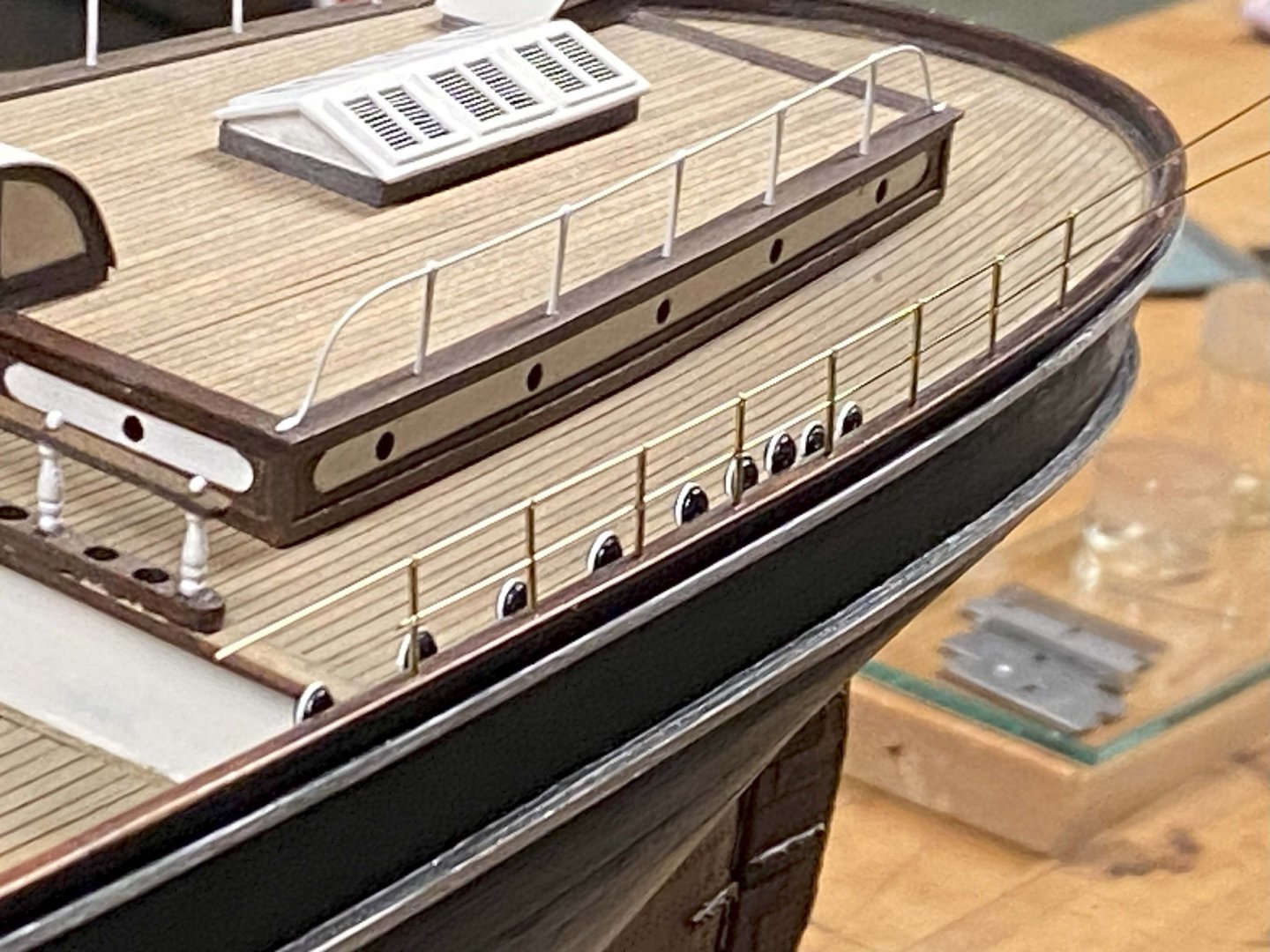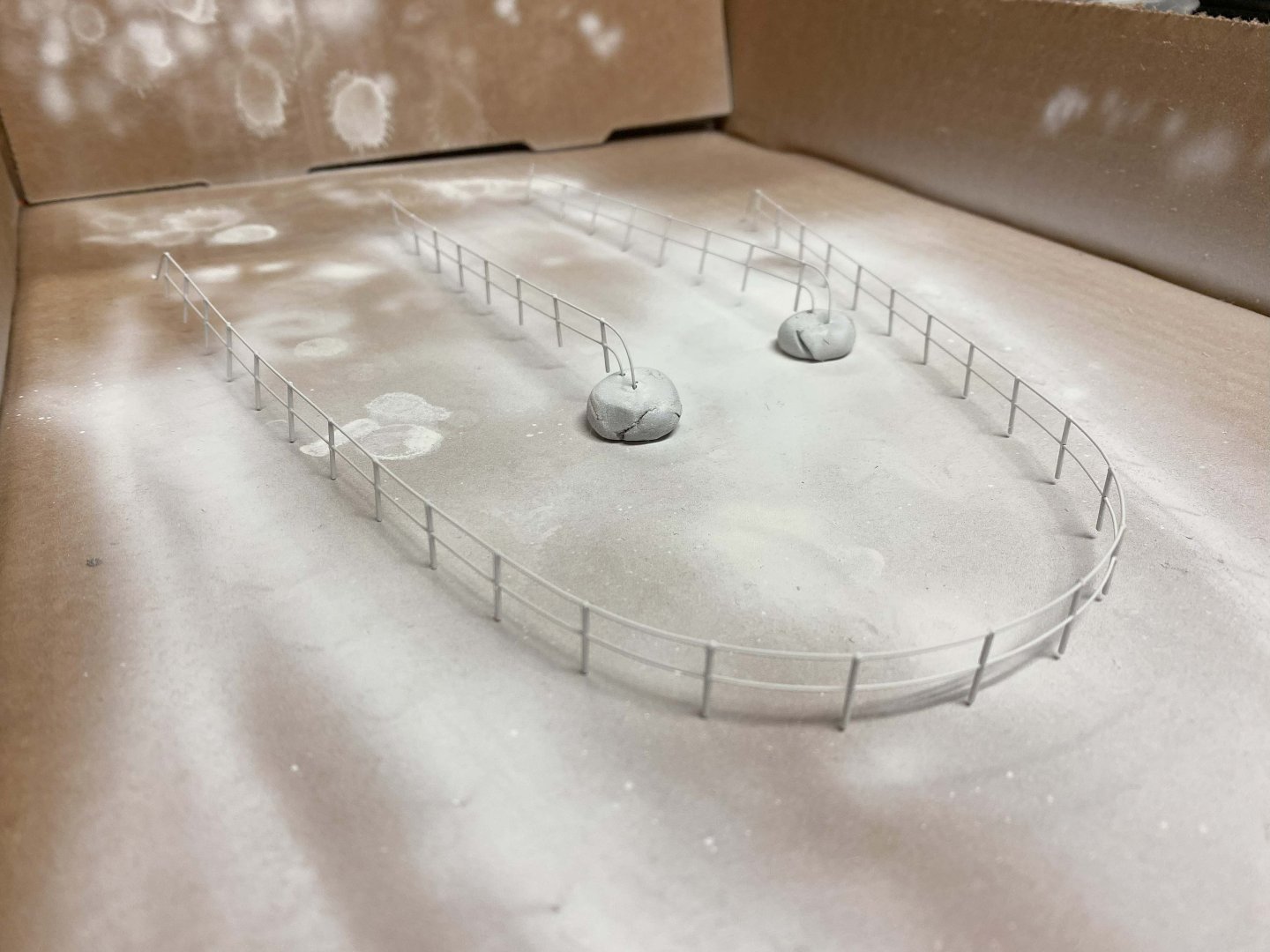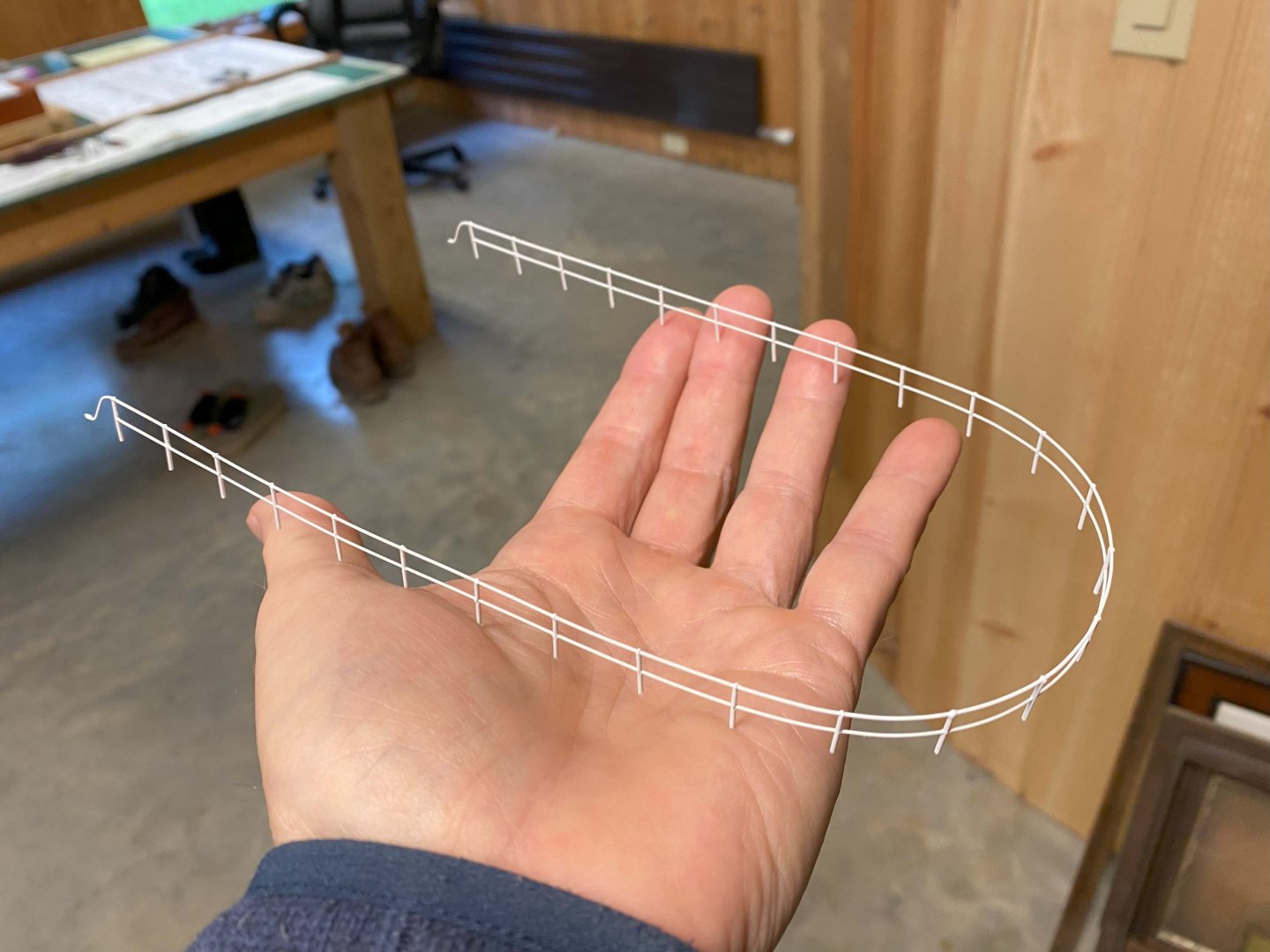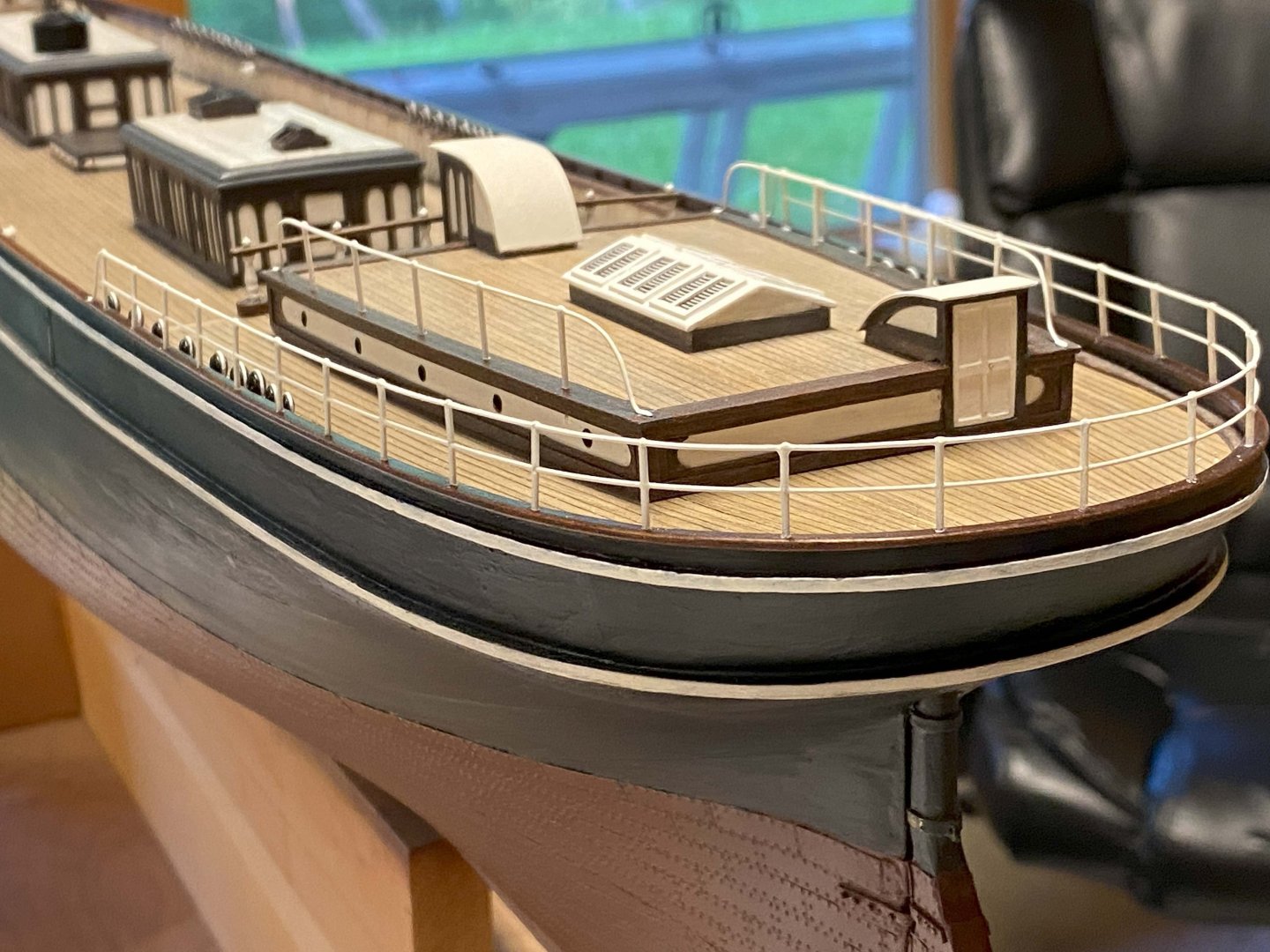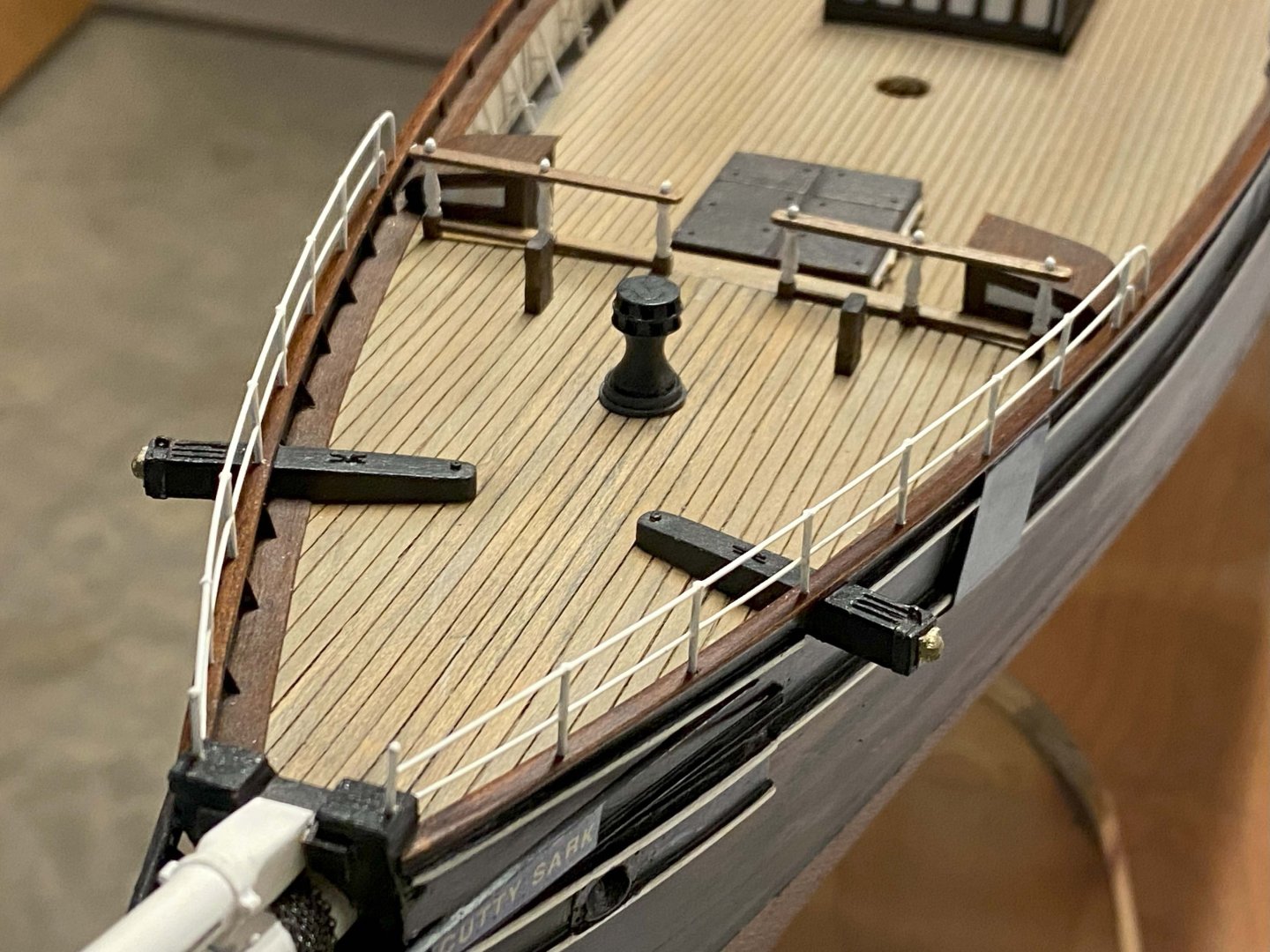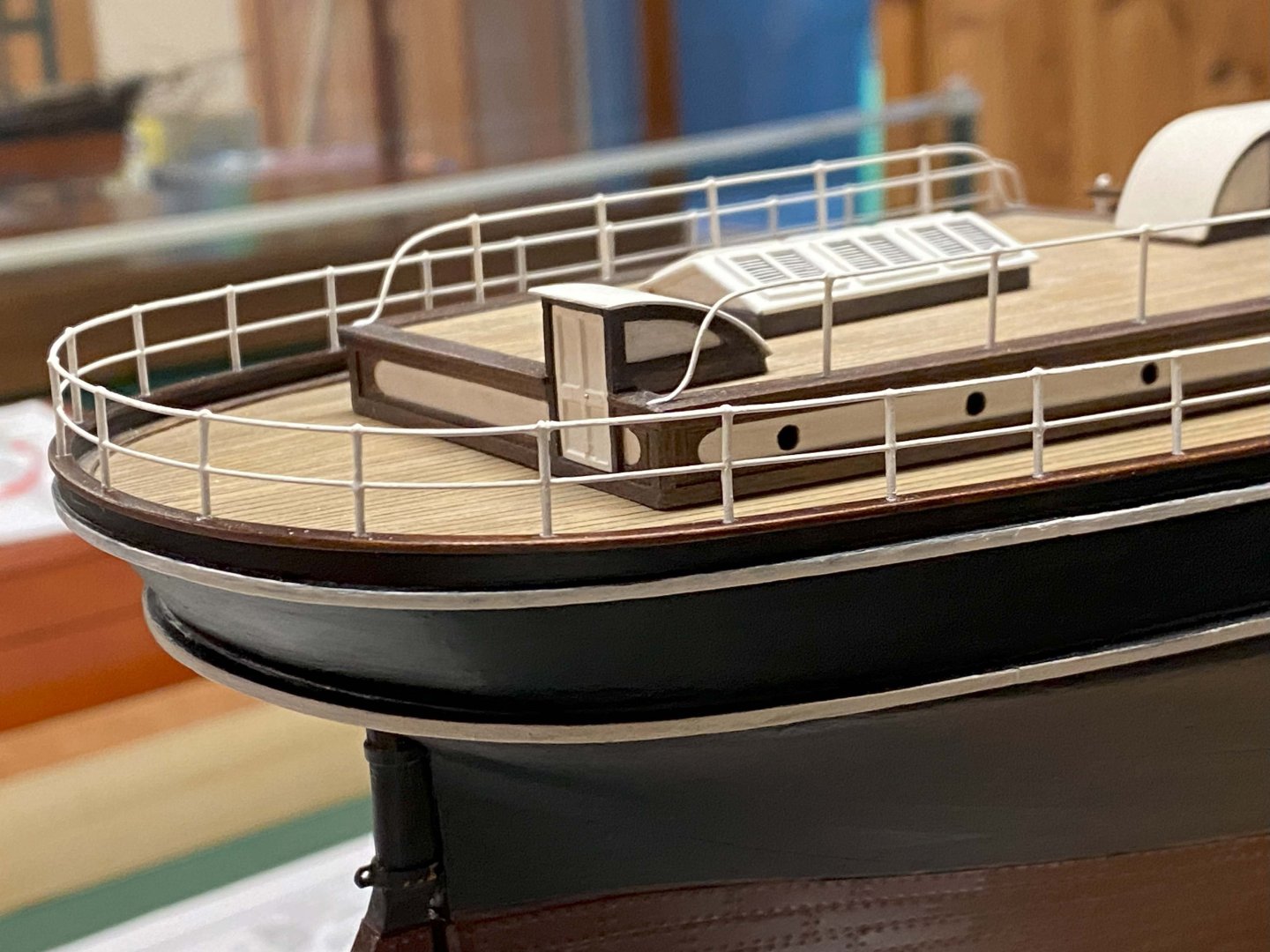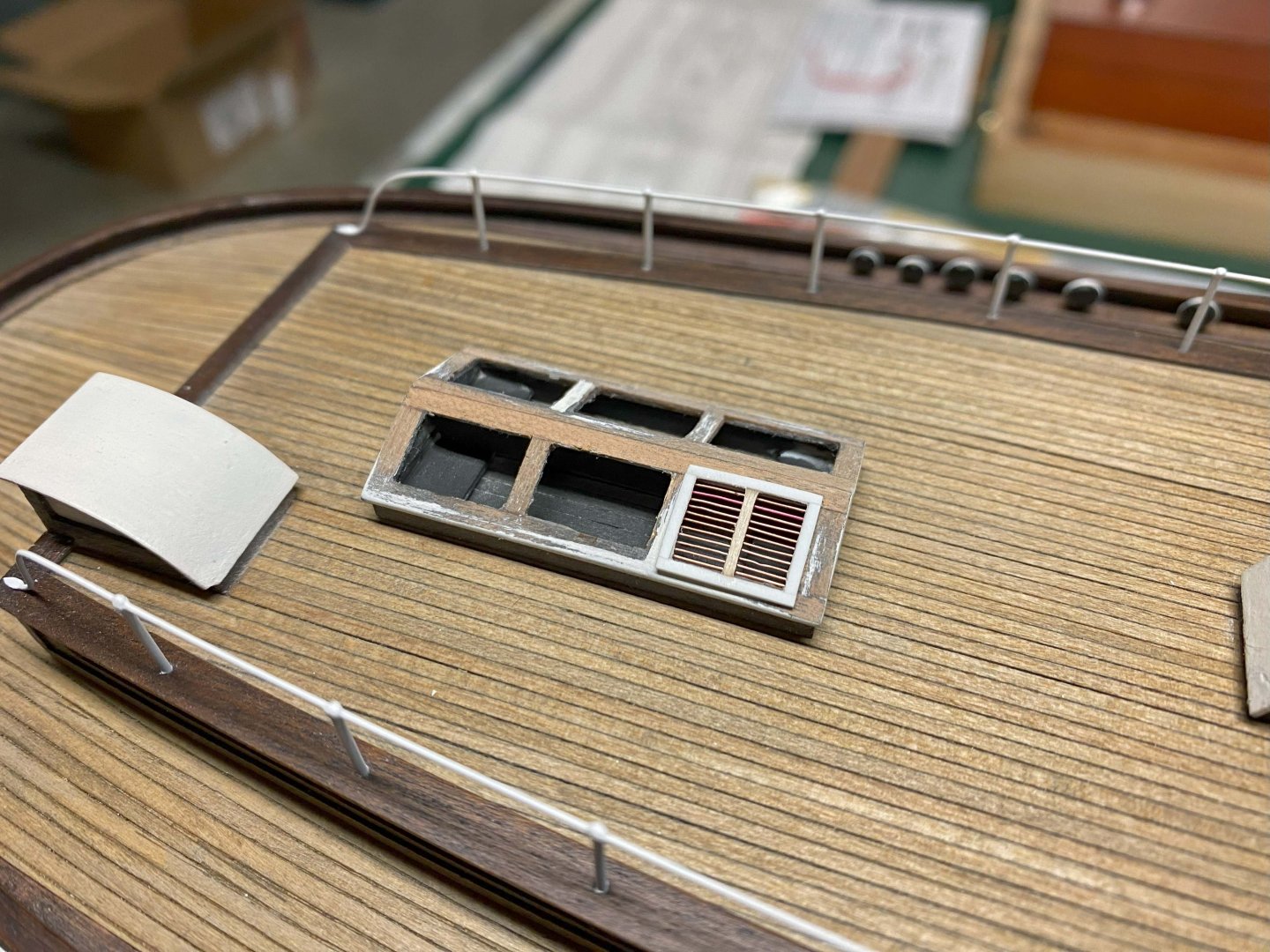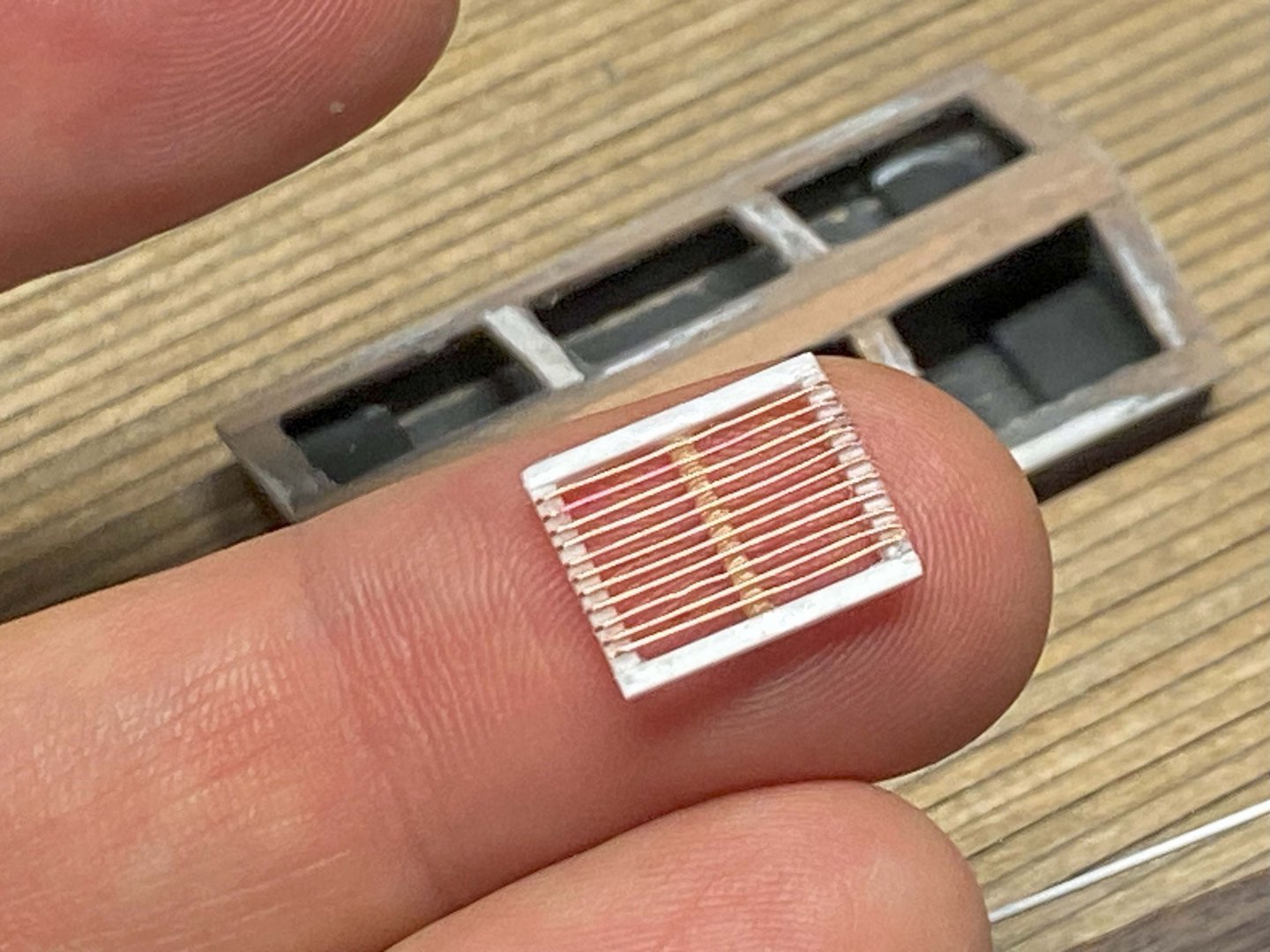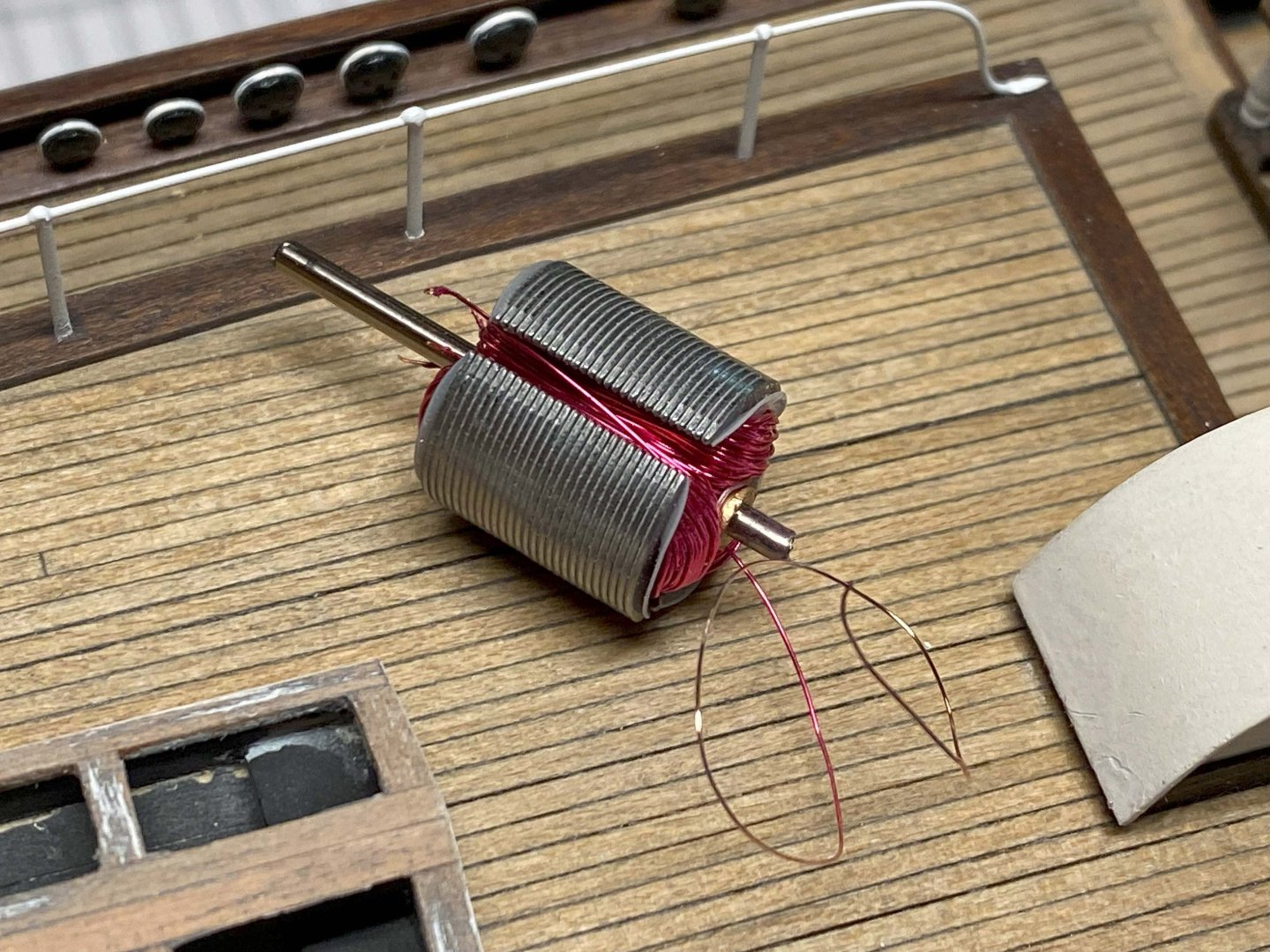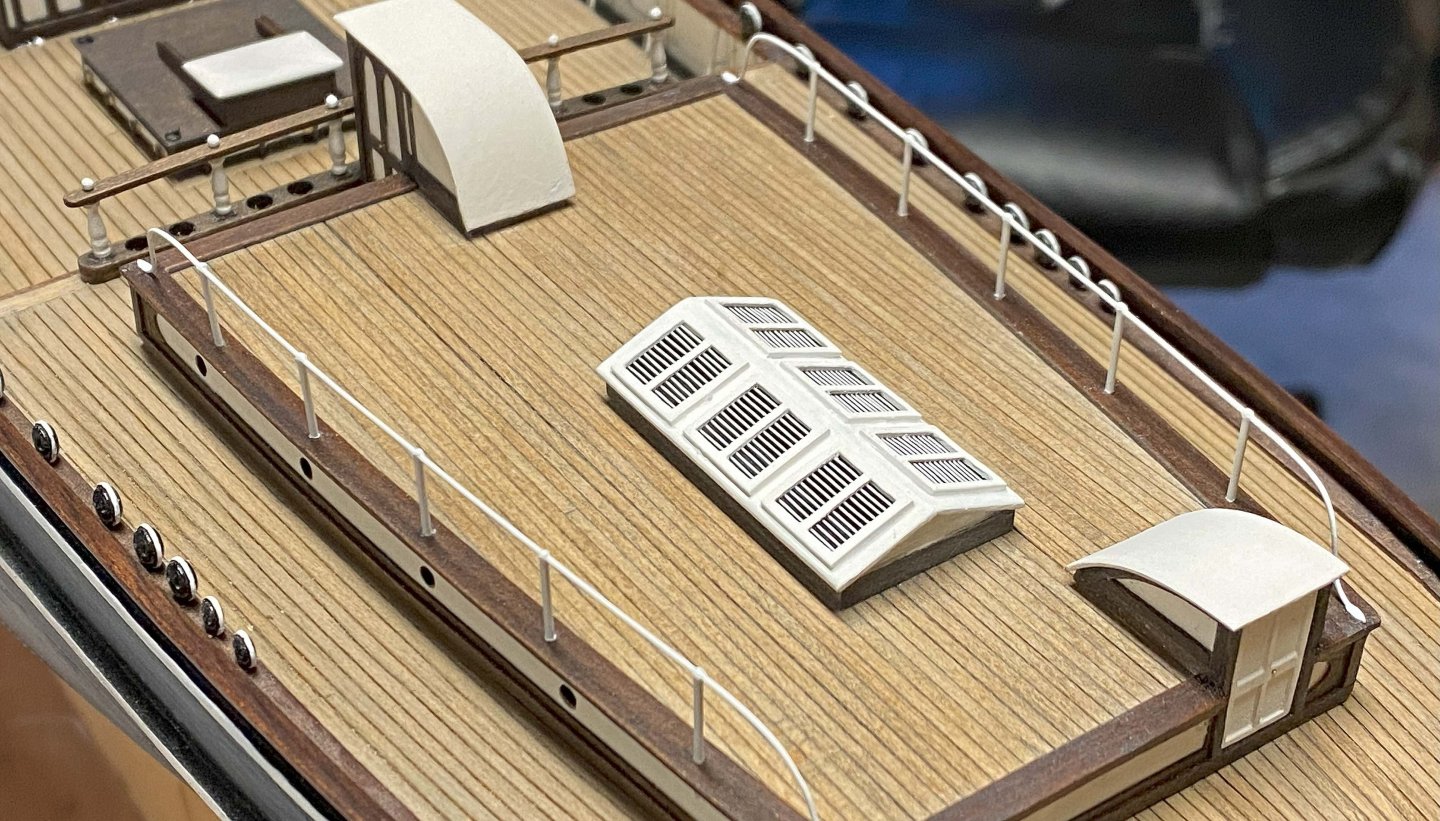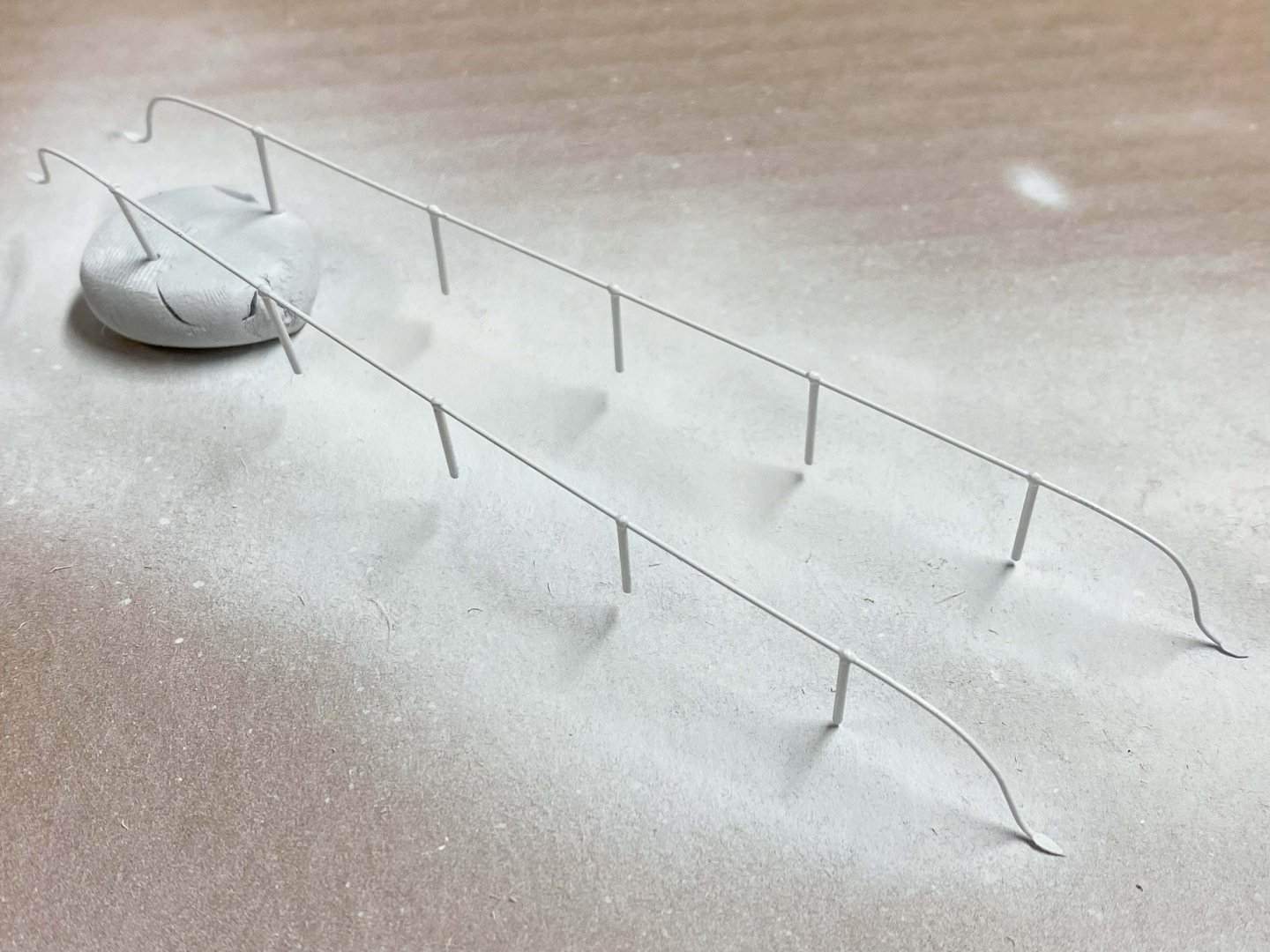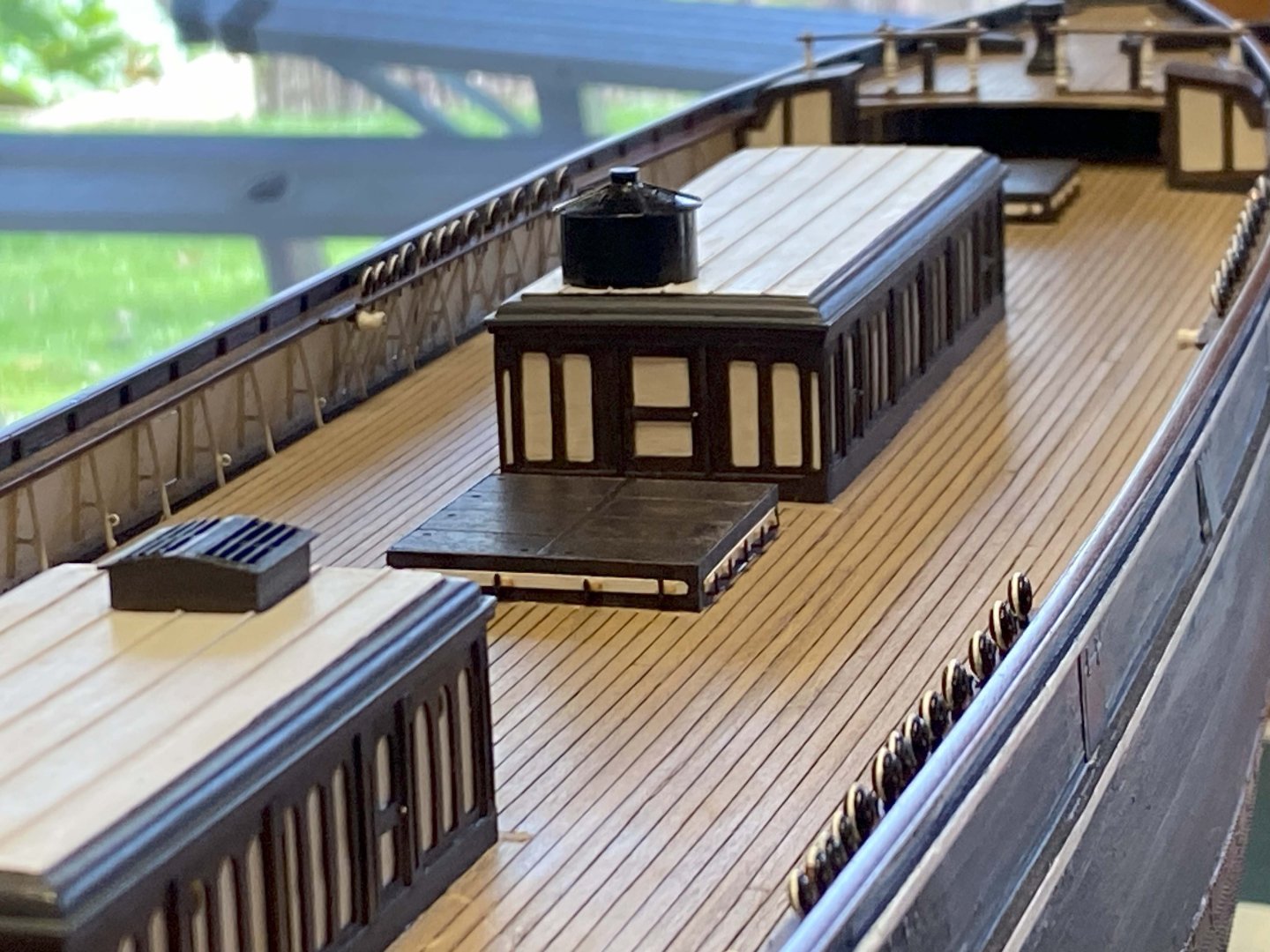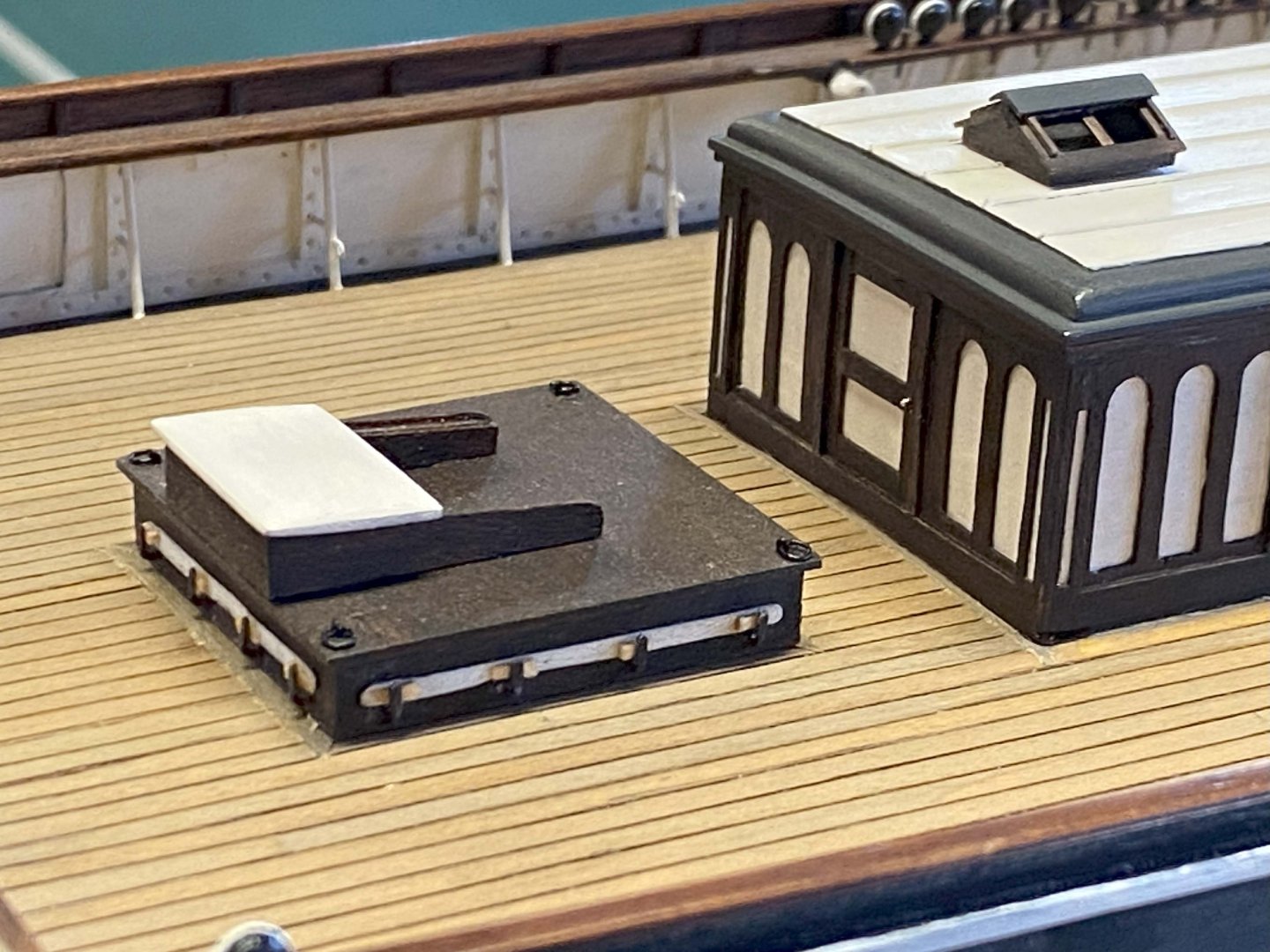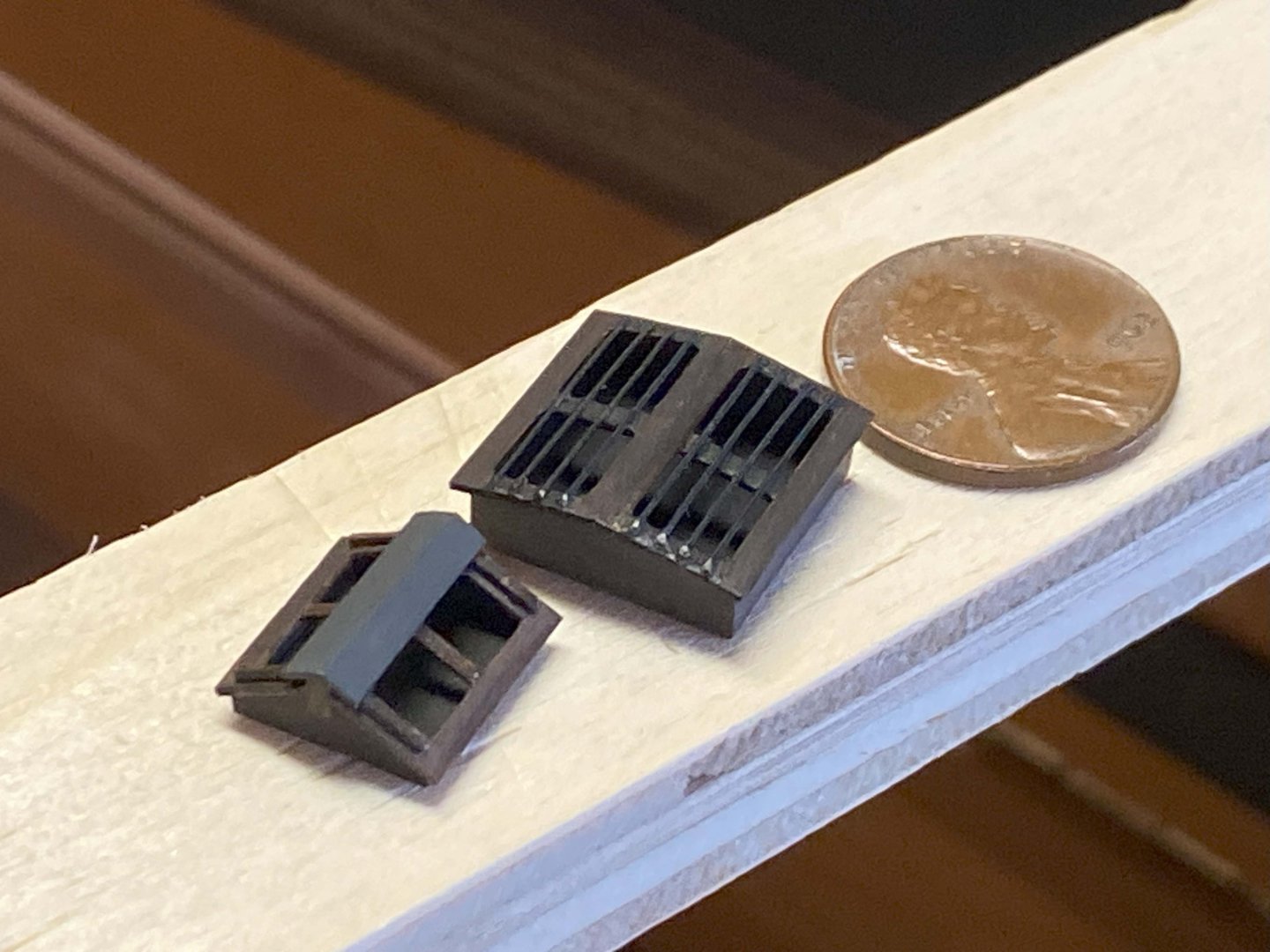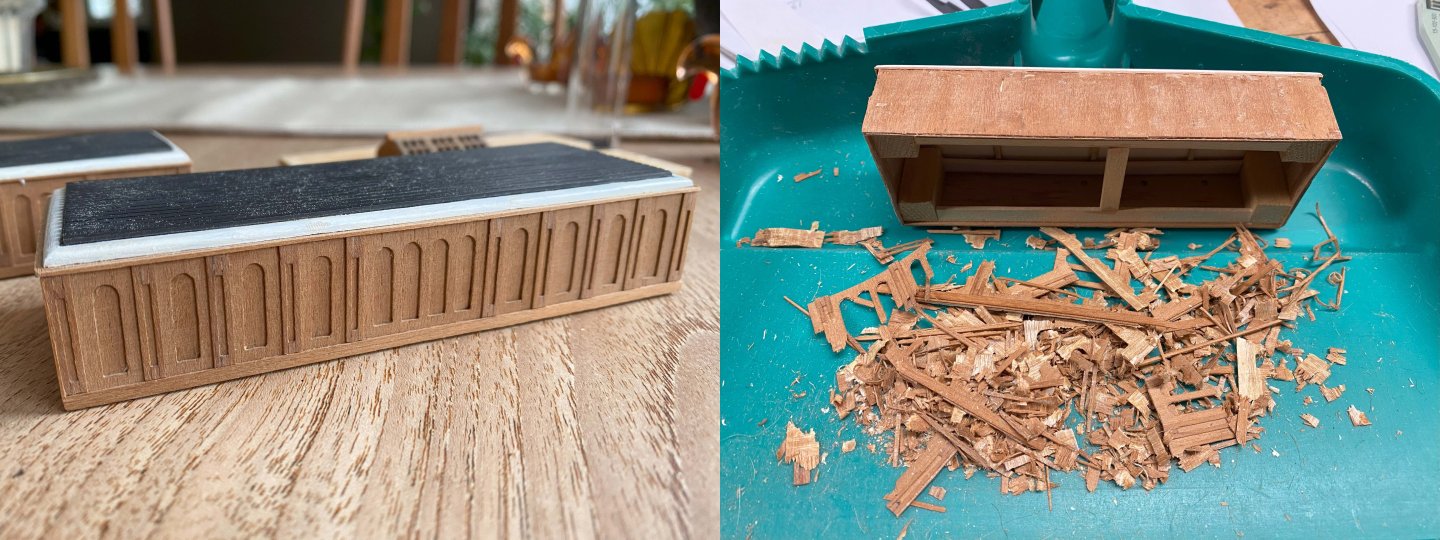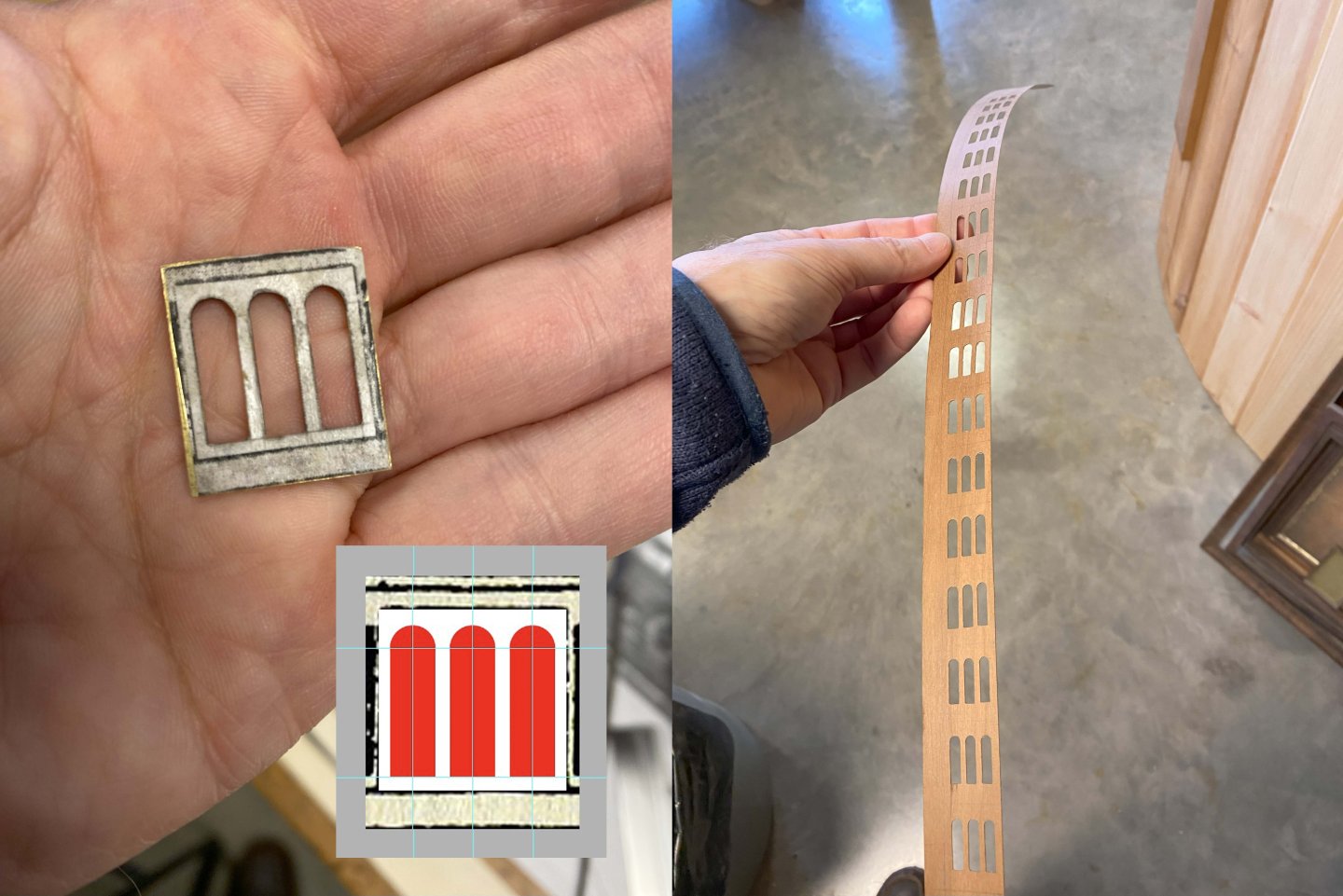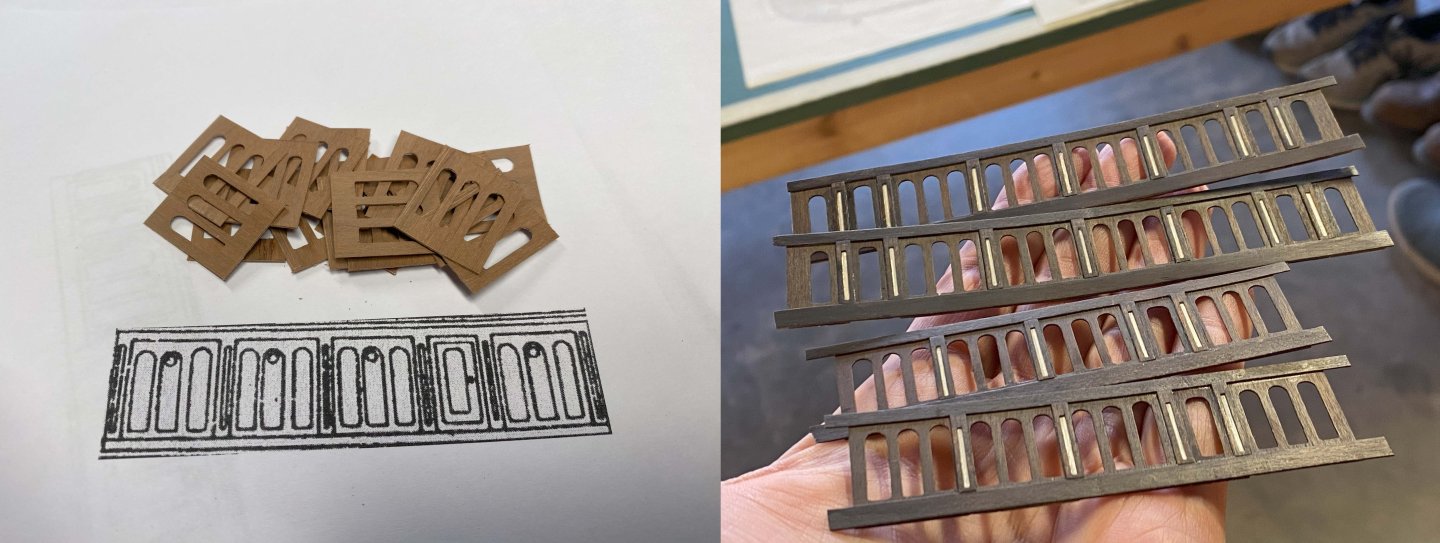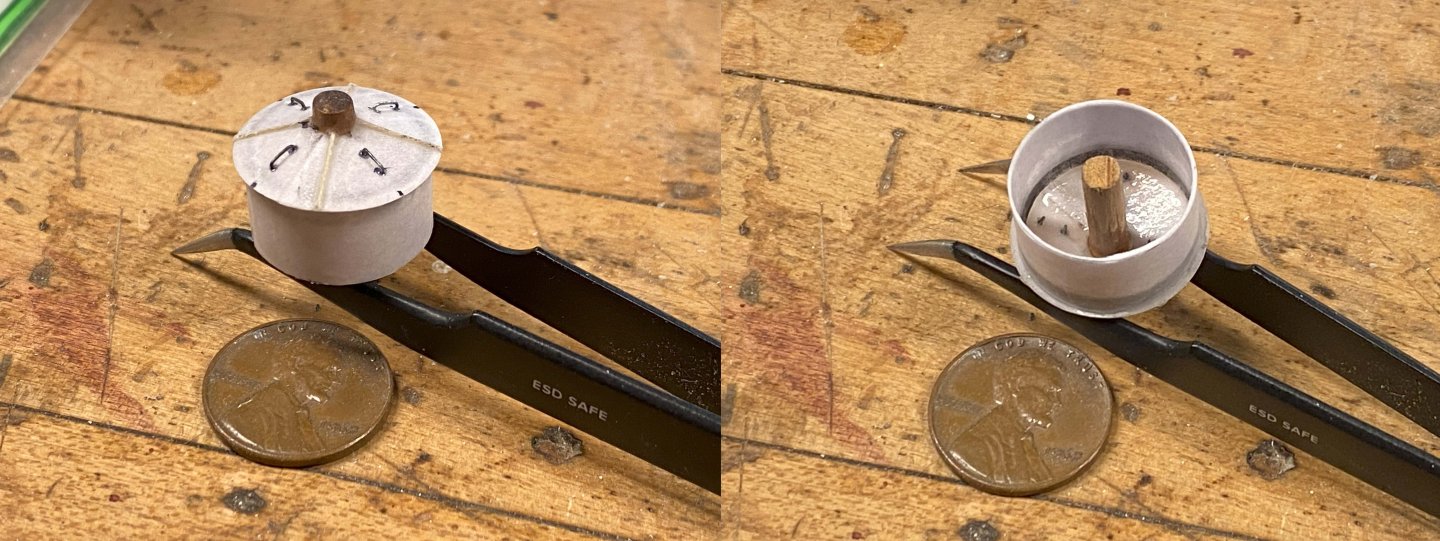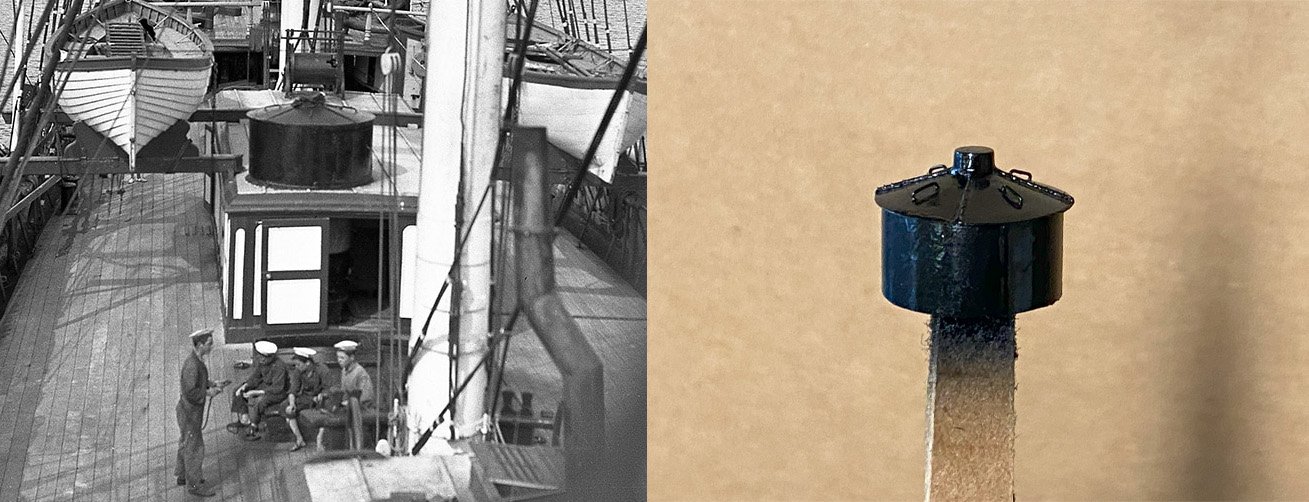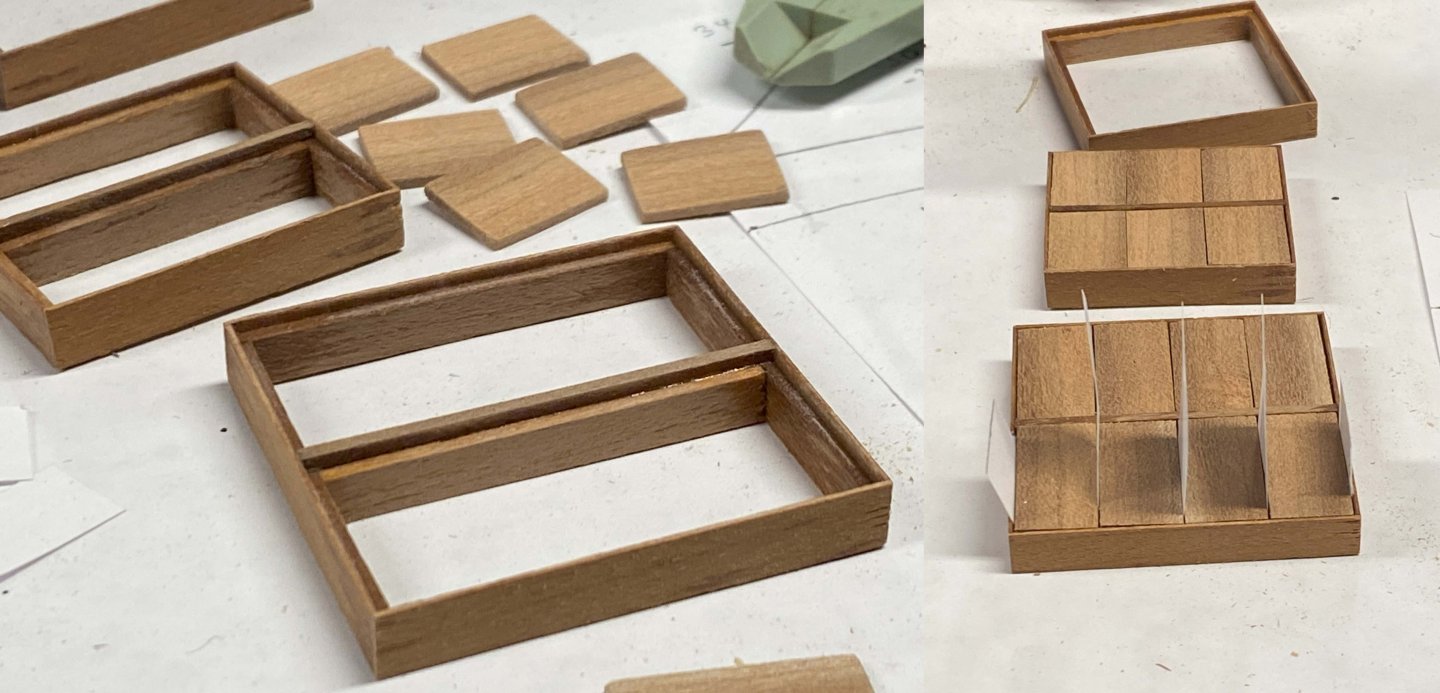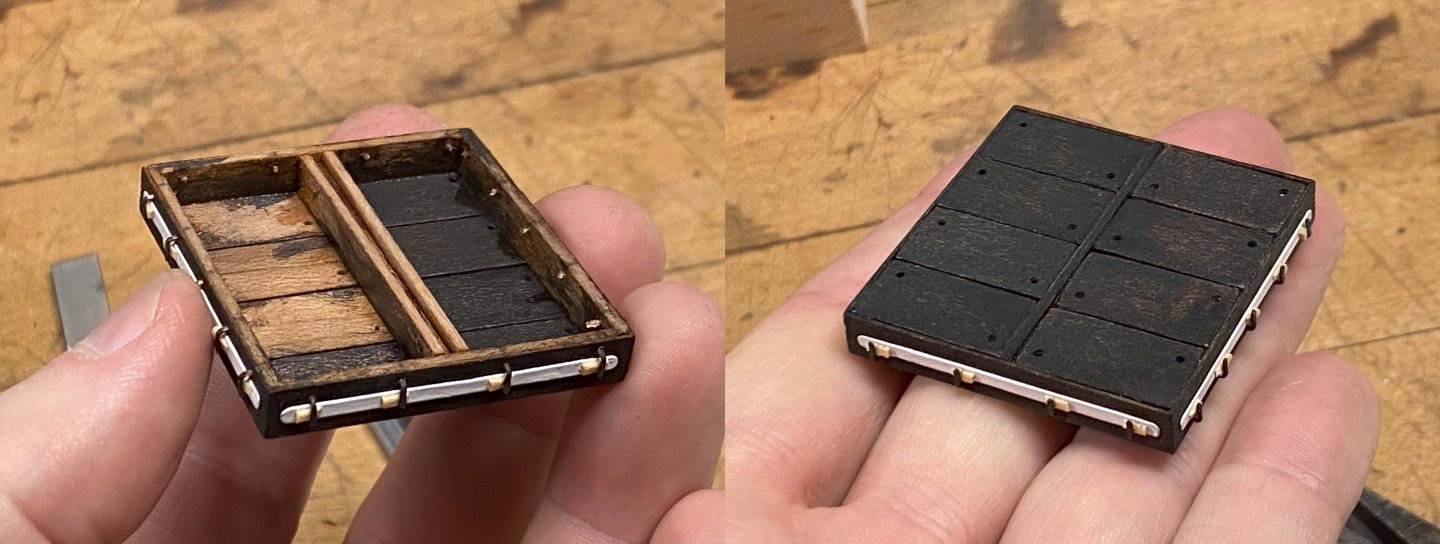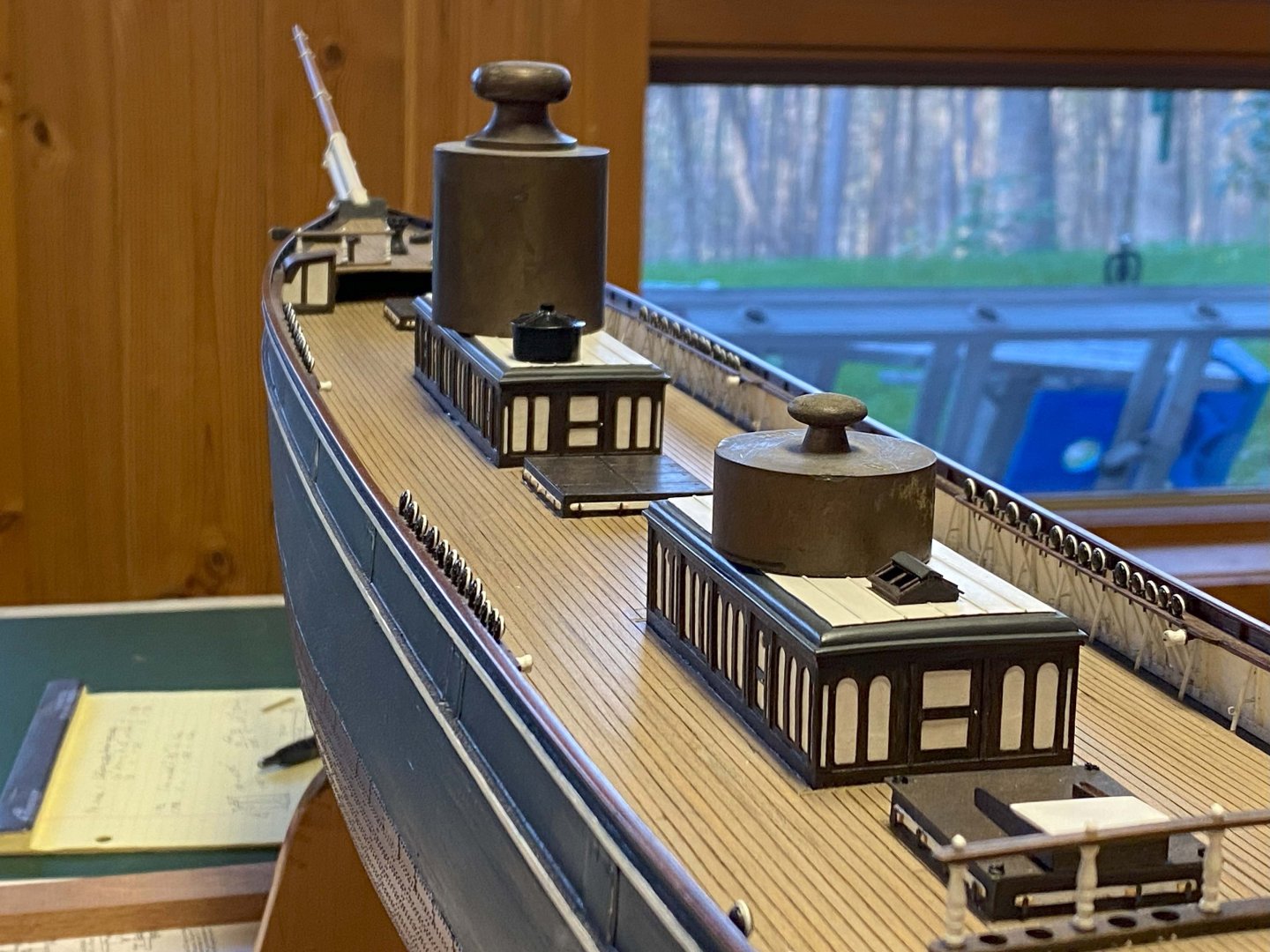-
Posts
67 -
Joined
-
Last visited
Content Type
Profiles
Forums
Gallery
Events
Everything posted by uscharin
-
After the bilge pump I needed to do something relatively easy. I'm happy to say the hen coops turned out well and are ready to be installed. The coops were widened at some point before arriving at Falmouth. The current CS restoration/reproduction has them close to their original as-built size. You can see in this early Falmouth image that there is an extra foot. This extra foot marks the original outside corner and was no doubt still in place in order to support a weak rail splice. I made up bar panels and glued to rectangular wood tops and bottoms. Hard to believe the coops consumed over two feet of 0.45mm brass rod. I had to tack-glue the coops to a stick in order to spray paint them. The original coop bars were made out wood and were square(ish). One of my sons was recently in London on business and took time out to visit the CS. He reports it was a great experience to see it in person, something I have yet to do. The "water" dome that the ship sits in always leaves me unsettled. The effect looking up at the ship from within is quite grand. On the exterior, it looks like she is sitting on a water balloon that is about to burst. It is absolutely not complimentary to the lines of the ship and find that very unfortunate.
- 85 replies
-
- Cutty Sark
- Sergal
-
(and 1 more)
Tagged with:
-
Haha, yes, I'll enjoy making them, but it will also likely be a little painful. The iron end castings are where the real work will be. Thanks for the compliment. Just finished looking over your 3d printed CS offerings. Really nice prints and the resolution looks really good. Must be a pretty nice printer. If you offered your parts in my scale I might have been tempted. Kevin, your CS model looks great but I'm sure your Victory is soaking up all you time and effort. Ron
- 85 replies
-
- Cutty Sark
- Sergal
-
(and 1 more)
Tagged with:
-
Can't believe this little bilge pump took me three weeks to build, but it did. Turned out to be pretty challenging. Most of the parts took me at least two attempts to make and I had to walk away several times to gather myself. In the end, I have something I can live with. I think my next task will be the chicken coops before tackling the deck winches. As with the fife rails, the pump is not glued down yet. I'm waiting until the masts can be set in place to help with positioning. Most of the pump is made out of brass. The wheels were perhaps the greatest challenge. What you see below is how I managed it. I first formed a ring out of brass wire and then drilled holes to receive the spokes. I then made the hubs by drilling receivers for the brass spokes in solid brass rod. I kept both hubs together, as you see in the middle pictures, until I could lace the spokes and solder. After the first wheel was finished I parted it from the rod and moved to the second. In my first attempt at this I cut the hubs out first which was disaster as it was pretty much impossible for me to manipulate the hub while lacing the spokes. Leaving the hubs attached to a rod make it much easier as I had something to hang onto during the assembly. The pump cans came next. I filed a face on a brass tube (see first picture) and then cut sections that then got soldered together in pairs. That worked out great. The iron support posts were pretty tricky but was able to make mostly out of brass (middle picture). The problem came when trying to solder the opposing ribs. The part would heat up too fast causing the entire assembly to fall apart. The solution was to glue in wood and then shape (third frame).
- 85 replies
-
- Cutty Sark
- Sergal
-
(and 1 more)
Tagged with:
-
Congratulations! Glad you have it under glass and really like how you did the sails. You can be proud. Ron
- 42 replies
-
- Cutty Sark
- Sergal
-
(and 1 more)
Tagged with:
-
Most of this update is work done about a month ago, at which point I had to stop ship building and tend to a couple domestic projects before the weather shuts me down. I had to chainsaw up and split two very large trees that blew down this last spring. I then restructured an external wall in my house so I could install two new windows. Everything seems to happen in threes, so it was no surprise when my geothermal heat pump broke down needing some significant attention. All of that is behind me now and today I am just resting my bones and thinking about ships. Bollards. Made all of them out of brass, which is very suited to the task. As usual, I didn't appreciate how much work they were going to be. There is a dozen of them in total, some very small that mount to the main deck rail and the biggest ones that mount on the main deck. The largest ones on the main deck, in reality, also can serve as vents. I added a picture of some men restoring the brass screw vents. I had intended to add unpainted brass caps to my bollards but decided not to when I realized they were painted over with black paint at early Falmouth. A lot of brass was painted over at that point in time to save on maintenance. Fife Rails. It is often said that it is important to research the period in time that you intend to model. Over a ships history so much can change and that is especially true of CS. The fife rails are a good example of this. The as-built arrangement of main deck fife rails is different than what you would see in today's restoration and again different than what you would have seen at early Falmouth. At Falmouth the foremast was flanked by two rails, one square-posted (fore), the other round-posted (aft). The main mast had one (fore) square posted rail, where the as-built arrangement would have had an additional aft mounted square-posted rail, which apparently ended up going to the foremast when the Portuguese owned the ship. In today's restoration the round-posted fife from the foremast is now aft of the main mast and bilge pump. The early Falmouth arrangement was no doubt executed by the Portuguese, and probably when it was re-rigged as a barkentine. Wish I had more pictures to share of my work. I seem only to have pictures of how I made the square-posted sheave escutcheons. The square-posted version has three sheaves on each post where the round ones have a single sheave, which I have yet to complete. I have not glued down the rails yet as I'm still not sure of the spacing from the masts. I included a ca1922 picture provide by Longridge of the foremast arrangement at Falmouth. It looks to me that the aft rail sits closer to the mast, but not sure. Originally, the round-posted rail was located where the square-posted fife sits. It was brought to my attention that the binnacle would have been kept polished and I had to agree, even though I'm sure its maintenance would not have been up to seaworthy standards. I tried my best to polish it without breaking it off and then lacquered it. At some point I'm going to shave down the wheel grips a bit as they are simply too big for my liking. Here are a couple overviews of the ship. Getting there... slowly.
- 85 replies
-
- Cutty Sark
- Sergal
-
(and 1 more)
Tagged with:
-
Hello Julie, Am enjoying your work as you come at this sort of project with a unique background and diverse skill sets. I find it very interesting and refreshing. Had never considered using hide glue on my model. Personally, I use a variety of adhesives but mostly 5-minute epoxy and some CA. I have used hide glue for decades on various restoration projects, primarily veneering. For sure it has many advantages, but convenience is not one of them. I'm curious how the hide glue works for you in ship modeling. Keep up the fine work! Ron
-
Haha. Yes, I asked the young cadets where it was stowed, and they had trouble finding it. I'll take pictures for a later post, but I did my best to brighten it up without breaking it. I then coated with lacquer to slow or arrest tarnish. It does look more "right." For such a small part, a little dark contrast helps give it dimension and that is still the case as I could not get into all the crevices. My feeling is that when the cadets were on board they would have been charged with such tasks as polishing the brass, if only occasionally. I have one picture of the binnacle in early Falmouth that shows it with large blotches of corrosion. B&W pictures can be hard to interpret, however. I'm happy with how it now looks and so is my wife (which has good taste is such things). Bob, your Staghound is moving along at warp speed. Meanwhile, I must have spent the last two days just making bollards. The accumulation of detail is really starting to bring her to life. Alway feel inspired by your attention to detail.
- 85 replies
-
- Cutty Sark
- Sergal
-
(and 1 more)
Tagged with:
-
You are right, of course. Don't know what I was thinking. Thanks for sobering me up! I'll be sure to feature the polishing results in my next update and am sure it will really improve the look. Ron
- 85 replies
-
- Cutty Sark
- Sergal
-
(and 1 more)
Tagged with:
-
Seemed like a good point to share some work. July was a super busy month for things other than CS. August has so far been relatively quite so have spent time working on smallish details that are important but are hugely time consuming. Makes progress feel very slow. The original binnacle is quite tall in real life at approx. 2 feet. The original stayed on the CS deck while at Falmouth and during this time was occasionally repositioned. I profiled the binnacle body on my 1/2" electric drill, from a brass fastener I found in my junk pail. The head turned out a little too big so proportions are a little off. No big deal. I soldered on the exterior parts and then blackened. I scoured off most of the black to get something that looks tarnished. My wife says it needs to be brighter so will probably comply. I floated some clear epoxy in the view port cavity to look like glass. Making the floor grate that the helmsman would stand on was quite difficult. The only way I could make this was by printing out on paper a scaled grid and then tack parts to it with CA. This helped a great deal with keeping the spacing close to correct. When it came time to cross-cut the grating I glued two strips of scaled grid to the front and then used a jewelers saw to make the cuts free-hand. Should have used a small razor saw as there was too much flex to the jewelers blade allowing for some drift. Still, it worked out. Once all the wood pieces were in place I peeled off the paper backing and sanded out. I intentionally made the whole assembly thicker to allow for sanding. Up to recently I never considered that these grates were very important in keeping the deck from getting worn down, in addition to improving footing. I made a ladder for each of the two main deck houses. They are super small so used the same technique as with the grating. I'm showing the paper peels that came off almost intact. I stained and then sealed all the wood with shellack before assembly which no doubt helped with paper release. You can see in this image one of the four mooring pipes I put in days ago. Made three sets of steps, one for the forecastle and two that lift you to the poop deck. Tried pretty hard to get the stair profiles to look right. Before I could fit the forecastle steps I had to install my Walker windlass and make the forward hatch (formerly a companionway). I also had to paint the brass studded chain which would have been a nightmare without my airbrush. Hand painting that small chain would have looked terrible. As the model progresses I will judicially add some weathering powders to the chain. I added two chain pipes to my windlass, wrapped the chain onto the wildcats (pocket drives) and then glued in place. The windlass serves only to hold the chain ends as you can not see it without a borescope. I could have completely left it off the boat but as I have said before, it is important to me to have it there. I also installed the poop smoke stack. At this point in her life the stack was not in use and is cut back and capped.
- 85 replies
-
- Cutty Sark
- Sergal
-
(and 1 more)
Tagged with:
-
Fourth time the charm? This will be short. After placing my new helm on the CS, something simply did not look right. Turns out the poop skylight I had just finished redoing was way too large. It made everything around it look wrong. Proportionally it was not too bad unto itself, but the overall size was way too big. I did not check the dimensions against Campbell's plans, which was a huge mistake. Of course, smaller is harder. The big problem was reproducing the metal protective bars. The fine electric motor wire I used in my last attempt was now far too big. I ended up sacrificing an old USB cable to harvest the fine wire within. Of course, the fine wire was a nightmare to work with. The bars add a great deal to the look so really wanted to have that modeled. This is what I had to do: These closeup pictures make the wire look not so bad. Reality is, it was like working with baby's hair. I tried all sort of ways to stretch this wire into a pattern so I could then glue it to the panels. I tried double-sided tape, etc., to hold the wire into position but it always allowed too much creep. I printed out two paper patterns with spacing that I felt would work and then glued to a piece of plywood. I then drilled holes at either end to insert the wire and then soak with CA. On one end the holes go all the way through the wood so I could gently pull the wire taut and then fix with CA. This method worked fairly well but several of the wires broke during the process so had to redo them. At the end, some wires ended up slacker than others. I re-tensioned the wires by using a couple small brass rods. I then slid a piece of wax paper under the wires and then pressed down the skylight panels while introducing CA under the wood stiles. A very tedious process but got away with it. Once the glue had set up, I cut the panels away with a razor blade. The wire spacing could be improved a little after-the-fact by pushing the wire around with a needle. The results are not bad but still need to clean up the bars a little and try to straighten/space them a bit. The new skylight tuned out to be ~20 percent smaller, which magically made everything look and feel much more balanced.
- 85 replies
-
- Cutty Sark
- Sergal
-
(and 1 more)
Tagged with:
-
Thanks, Peter. The wheel was a real challenge. I will absolutely not try to improve on it, as I sometimes will do. Tough to be a perfectionist. I'm starting to get antsy to move on to masts and rigging. Love how your CS is coming along and looks really close to being finished. Are you going to case it? I hope so. Ron
- 85 replies
-
- Cutty Sark
- Sergal
-
(and 1 more)
Tagged with:
-
Lots going on around the house this last couple of weeks. Lightning took out a lot of my electronics and black bears have added my home to their rounds. Electronics have all been repaired or replaced but I have not figured out how to keep the bears out of my cultivated raspberry patch. The cold war has begun. Despite all the recent drama, I have managed to model the CS helm. Maybe it's me but the ship's wheel is one of those features that I invariably look at first when viewing a model. It needs to feel realistic enough that I can smell the salt. For that reason, I poured a lot of sweat into this. Lacking modern conveniences such as a small lathe and mill, I knew this was going to be painful. I used the Campbell drawings to guide me in addition to LOTS of pictures, both old and new. The feet on the steering mechanism enclosure are turned in my model, as they were at early Falmouth. My guess is the legs were original to the ship. At some point in later Falmouth the legs were replaced with square ones as seen today. There was also an emergency tiller arm under the enclosure that I decided not to include as you simply would not see it. The emergency tiller had two eyelets that could be hooked up to tackle to steer. The brass facing on the CS wheel is a highly recognizable element and I definitely wanted to somehow create that. My best bet was to hammer out some brass rod and then form a ring. In order to hammer the brass flat, I had to repeatedly anneal the brass by heating to red and quenching in water. It would otherwise become so springy from hammering that it would become unworkable. I used a plug cutter as a mandrel to form the brass ring and also keep it stable while I glued a 0.5mm thin cherry strip over the outside surface. Once that was done I did the same thing on the interior face. Once the outside lamination had set up the ring became very dimensionally stable. I made the ring assembly quite wide and needed to be file dressed down to final dimension. Once that was done I laminated an additional layer inside and out with slightly narrower cherry strips. Altogether, this mimics the original wheel construction. Making the grips and spokes was a massive headache. I made up 1mm square "sticks" for this purpose and tried to turn the profiles using my hand held Dremel tool. I don't know what the slowest RPM is on this tool, but it proved to be way too fast causing the frail sticks to self-destruct. The solution was to hand carve each one. Not too bad as there are only 8 grips. I used a razor blade and tiny files and did all the work free hand. Naturally, there is a lot of variability between each part but not enough for my eye to easily catch it. After the grips were made I cut notches on the wheel using nothing more than a razor blade. The hub is made up of two brass tubes and a solid bar which I happened to have on hand. Forming the central cap was done on my Dremel. I had to skin over the hub with more 0.5mm cherry and that turned out to be one of the more difficult tasks. I used a soldering iron to heat-bend the strips for the outer wheel, but heat alone would not work over a 2mm radius. So, I soaked a strip in ammonium hydroxide overnight and then made a couple wraps over a scrap piece of brass tubing of the same diameter. Once dried the wood held its shape and could then easily be glued into place. As an aside, I have recently read a few posts critical of the use of ammonia for bending wood. Personally, I have used ammonium hydroxide in general wood working for decades with absolutely no issues. Ammonia gas dissolved in water gives you ammonium hydroxide. Wood in general is slightly acidic, so soaking in ammonium hydroxide will neutralize the acidity (think paper document deacidification). The ammonia goes off as a gas leaving water that then evaporates. I would rather risk the wood being slightly alkaline over acidic. I ended up making the spokes free handed as well. Given their size, adding much detail by hand was almost impossible for me. Interestingly, the Campbell drawing of the wheel illustrates a different spoke turning profile than the original. I attached the spokes to the wheel the same way as the grips. It became painfully obvious that trying to install the spokes with the hub in place was going to be far too difficult. Instead, I glued in the spokes and then carefully radius the ends with a file until the hub fit. Sounds difficult but ended up being quite easy. Just had to be very careful and use a backing so the spokes don't break out.
- 85 replies
-
- Cutty Sark
- Sergal
-
(and 1 more)
Tagged with:
-
Rob, thanks for the complement. Means a lot coming from you as I respect your work immensely. Taking a few days off then will decide what to work on next.
- 85 replies
-
- Cutty Sark
- Sergal
-
(and 1 more)
Tagged with:
-
Finished the outer railings and am happy that is behind me. The job required a little trial and error but worked out in the end. Started out making all the stanchions using the same methodology as in post #48. This wasn't so bad. Trying to accurately place the second course rail turned out to be the trick. Like with the top rail I wanted to evenly, and symmetrically, crimp the brass rod before drilling. This would make it easier to drill the second hole and also give the solder a place to build up to yield something of a spherical look. My attempts at flattening the junction with a punch sort of worked but was far from repeatable and definitely not symmetrical. I ended up partially sacrificing a small pair of end nippers to do the crimping. I gradually ground out a gap in the jaws until I could crimp the rod to what looked like a good depth. Trial and error. The tool worked exceptionally well. Next came drilling the hole, which for the second rail is 0.45mm. Top rail is 0.5mm. As was suggested to me, I made up a prick punch out of a 1/16" HSS drill bit. I ground the end to a sharp point. Trouble was, the target is so small I could not accurately guide the punch to the correct spot due to shadows, my eyesight, fingers in the way, etc. More importantly, even lightly striking the punch would tend to fold the rod at the flat and seriously weaken the intersection. In the end I had little choice but to free hand the drilling. Took a while and only ruined about 3 stanchions in the process. I made a little jig to hold the stanchions for locating second railing hole. Kind of crude but made a really nice crimp. The crimp. The process elongated the stanchion by 1mm. I also added a reference mark that would be top of wood rail and one for total length. Pretty small. Looks like a string of firecrackers. Before trimming to length. I pressed each stanchion into a drilled hole (no glue) and then strung the wire rails. On a tight radius I had to feed the stanchions on one at a time. Once everything was in place I went around and soldered each intersection. Once everything is soldered, I could carefully remove the whole assembly to file imperfections and paint. It was surprisingly durable. Once painted I simply reinstalled.
- 85 replies
-
- Cutty Sark
- Sergal
-
(and 1 more)
Tagged with:
-
Correct. Specifically, early Falmouth just following Dowman's re-rig/restoration. Been thoroughly enjoying your Staghound project. I have learned a great deal. Also, very glad you are feeling better. Kidney stones are no joke.
- 85 replies
-
- Cutty Sark
- Sergal
-
(and 1 more)
Tagged with:
-
Another cold, wet day so decided to reno some recent work. Some of you may have noticed I tend to re-do a lot of my work. For sure, that is true. The poop skylight just looked too crude after a successful railing job, so attempted an upgrade, in situ. Same process as in last attempt except more experienced this time and also found some fine wire in my e-waste bucket, a small electric motor. I harvested the wire (0.16mm OD) which is far thinner than used in my last attempt and scales much, much better. Again, the "rods" were placed free handed. Tracking between rods look much better this time. Very hard on my neck muscles. Now that I'm happy with the skylight I will go back to working on the railings.
- 85 replies
-
- Cutty Sark
- Sergal
-
(and 1 more)
Tagged with:
-
Thanks for the tip. I think your approach will be needed for the outer two-course railing. My biggest challenge is not to let the hole distance between top and mid rail to fluctuate. The railing would end up looking terrible. I'll need to make or order something I can use as a mini punch and fabricate a fixture to hold the little stanchions from rolling around. I see this as a two-stage process where I'll use a small flat tipped punch to slightly flatten the intersection and then mark drill locations. I'm starting to feel better about this.
- 85 replies
-
- Cutty Sark
- Sergal
-
(and 1 more)
Tagged with:
-
So, accepted delivery of the brass rods I ordered and promptly spent an entire day working on the poop railings. The success of my plan was absolutely not guaranteed. Decided to post the results as I'm pretty happy that I have a method that worked, if not a bit tedious to execute. But that is all part of the challenge and satisfaction of modeling. I decided on 0.8mm rod for the stanchions and 0.5mm rod for the railing. That gets it pretty close to scale, but scale would be smaller sized. My eyes and hands would have trouble if much smaller. The process was to squeeze flat (~2mm) the end of a 0.8mm rod with smooth-faced pliers, then drill a 0.5mm hole through the flat. After that I filed excess brass from around the hole to make a tight ring. Once the hole is made, I then cut the stanchion to length measuring from the hole. The problem with my method is that the hole is never exactly where I want it as this is done free-hand and the drill tends to skate around. I learned something new about the CS after trying to verify the number of stanchions to make. The Underhill plans which I often reference (which are supposed to be based on Longridges Falmouth observations) show 7 stanchions on each side, while the Campbell (as built) plans show 5. After studying my Falmouth images, I counted 6! Most of my Falmouth images of the poop are taken from the port side. I haven't looked into it, but the CS was fixed in place, and I believe the port side was generally the side that received the best sunlight. I did however find a couple pictures where I could count the starboard side... and there were 5! This was a surprise and no idea why the difference. In the end I decided to go with 5 on each side despite the historical inaccuracy. I located and drilled holes along each side of the poop and pressed the stanchions into place. I then ran the railings. I did this as the stanchions are held in place while I soldered the intersections. After soldering I pulled the assemblies out to paint. I use a solder that is 96% Sn and 4% Ag. I have my soldering iron set for 740C as the Ag requires more heat to flow well. I dabbed on some flux, applied a small amount of solder to the iron tip, and then applied to the joint. This makes it less likely to over-apply solder. It is totally a matter of feel as to how much solder to use. The goal is to fill the joint to make a somewhat spherical look. I had to paint the railings twice as in my zeal to finish I forgot to wash the flux off with EtOH. Paint doesn't stick to flux. My next step is to try and do the outer railings, which feature two rail runs. the lower rail is smaller than the top rail, so will use 0.45mm rod. These stanchions will likely be much harder to make but doable. A soldering test. Needed a little more solder. A late Falmouth image of the poop. Note the uneven stanchion counts!
- 85 replies
-
- Cutty Sark
- Sergal
-
(and 1 more)
Tagged with:
-
Have been inching along on the poop deck cabin. Far from finished and not glued into place yet but far enough along to show some measurable progress. In an earlier post I showed where I stopped work on the re-do some 40 years ago. I was in the process of reshaping it. I removed the old skylight, finished shaping the sides and then put down a new deck over the old one. As with the other houses, I used 0.5mm thick cherry veneer to layer up the vertical faces of the cabin itself and entry ways. The caps and entry tops were done with 1mm stock. Didn't turn out too bad but man was it a lot of tedious work. The most difficult part of the skylight was cutting the rods out of soft Fe wire. The real skylight features more guard rods but at this scale I had to reduce the number. As it was, I ended up gluing each rod into place freehand. Your eye can pick up the uneven spacing but not too much to spoil the effect. Next, I'll figure out a way to make the railings. Have been giving that a lot of thought. I don't have the brass rod sizes to do this so needed to order a selection. Looking forward to the railings and will at the same time probably work on all the other railings for efficiency's sake. Doesn't appear the poop railings are included on the current CS restoration, or maybe my pictures are too old. I will also be making a binnacle, stern lamp, and a couple other deck features found during the early Falmouth days.
- 85 replies
-
- Cutty Sark
- Sergal
-
(and 1 more)
Tagged with:
-
Now that spring weather has arrived, I've been 'fortunate' enough to have had a long spell of cold weather to keep me indoors. Found the time to work on the main deck houses and hatchways. The layout of the deck houses does change over CS's timeline. How exactly they were at early Falmouth proved a little frustrating. Just couldn't find enough written or photo evidence to make it all clear. In the end I defaulted to Harold Underhill's plans knowing they are not entirely correct. Back in post #38 I showed the deck houses as I had left them 40 years ago. Felt I could do a little better so made the painful decision to scraped them clean and started over. In this latest attempt I used a finer grained cherry veneer and dressed it down to 0.5mm thickness. The layering process yielded pretty good results. Everything is hand cut and filed so lots of variation. At least the variations are not too obvious to a casual viewer. At the point I'm modeling the CS, the main deck house roofs were covered over with a tarred roofing felt, as per Longridge. To help hold the felt down there were batten strips that ran the length of the houses. The forward house was fitted with a large freshwater tank on the roof. This tank was later removed. I still need to fabricate the cable compressor that mounts on the main house roof, along with various chimneys, vents, etc. The hatchways turned out pretty good. Again, all made with cherry. Pretty much everything I'm modeling uses either 0.5mm or 1.0mm thick veneer. The aft hatch is fitted with a booby companion way. Couldn't determine if the booby was fitted in early Falmouth, but it makes sense it was in order to help trainees have easy access to the tween deck. Made the hatch bars out of steel from a used alcohol can. The cleats are copper wire that I flattened with smooth-faced pliers.
- 85 replies
-
- Cutty Sark
- Sergal
-
(and 1 more)
Tagged with:
About us
Modelshipworld - Advancing Ship Modeling through Research
SSL Secured
Your security is important for us so this Website is SSL-Secured
NRG Mailing Address
Nautical Research Guild
237 South Lincoln Street
Westmont IL, 60559-1917
Model Ship World ® and the MSW logo are Registered Trademarks, and belong to the Nautical Research Guild (United States Patent and Trademark Office: No. 6,929,264 & No. 6,929,274, registered Dec. 20, 2022)
Helpful Links
About the NRG
If you enjoy building ship models that are historically accurate as well as beautiful, then The Nautical Research Guild (NRG) is just right for you.
The Guild is a non-profit educational organization whose mission is to “Advance Ship Modeling Through Research”. We provide support to our members in their efforts to raise the quality of their model ships.
The Nautical Research Guild has published our world-renowned quarterly magazine, The Nautical Research Journal, since 1955. The pages of the Journal are full of articles by accomplished ship modelers who show you how they create those exquisite details on their models, and by maritime historians who show you the correct details to build. The Journal is available in both print and digital editions. Go to the NRG web site (www.thenrg.org) to download a complimentary digital copy of the Journal. The NRG also publishes plan sets, books and compilations of back issues of the Journal and the former Ships in Scale and Model Ship Builder magazines.


